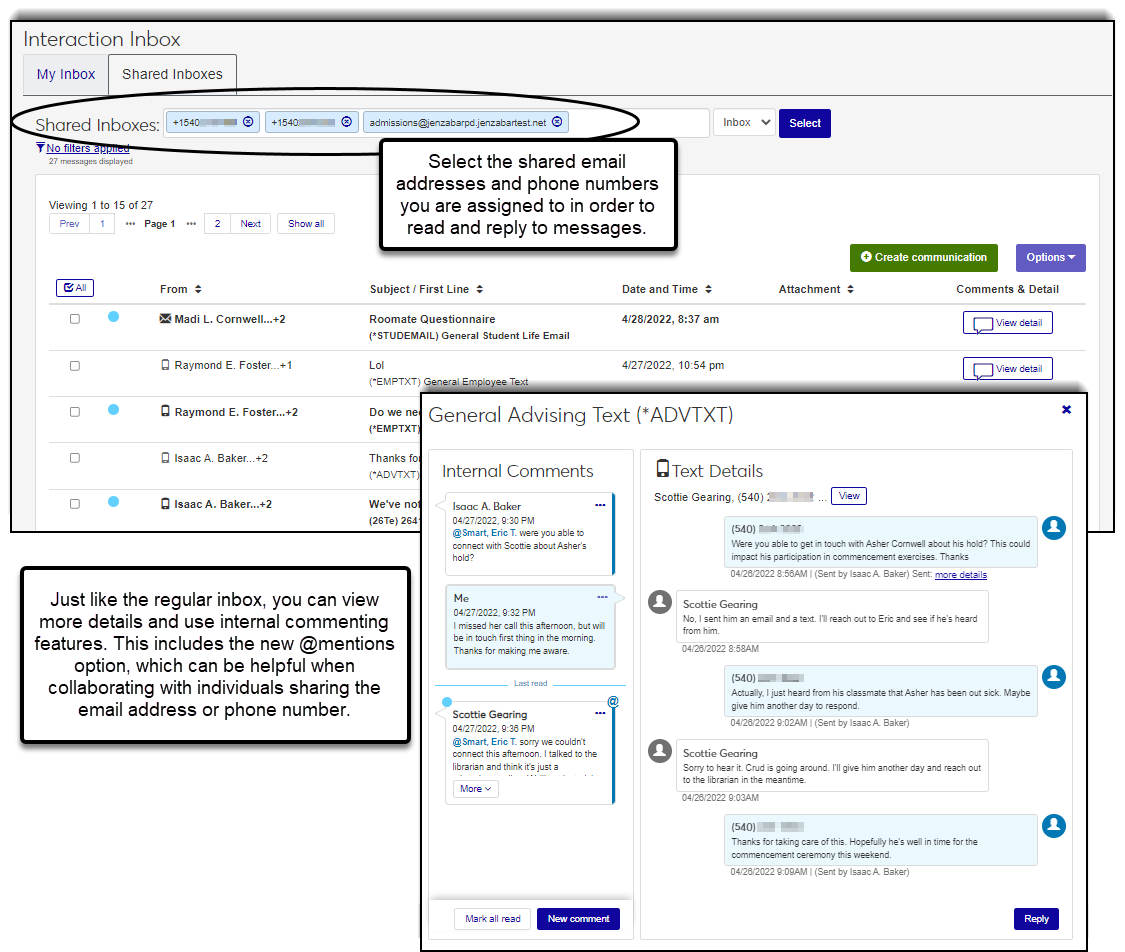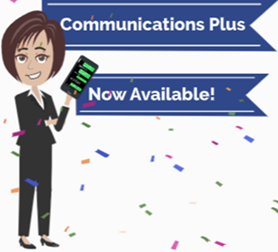Communications
Tip
Only releases with enhancements or resolved issues for this module have content below.
To help troubleshoot delivery issues and better understand recipient engagement, you can now view detailed information about email and text interactions in the interaction Preview window.* For emails, events such as processed, bounced, opened, and clicked appear. If a link was included, you can see whether a recipient clicked it and when, and for opened emails, information such as the recipient's IP address, operating system, and device type is shown.
For text messages, information about progression such as delivered, failed, and undelivered appears.
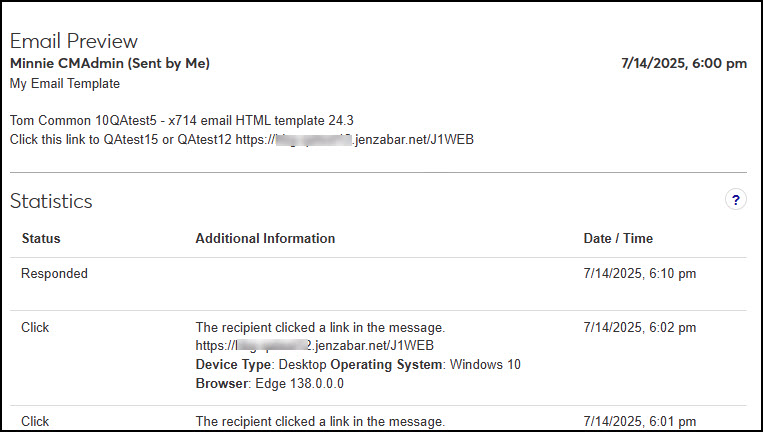
Note
New permissions are not needed to view delivery information.
*Available with Communications Plus.
The new Communication Timeline page lets you track all your future scheduled interactions—including texts, emails, notes, notifications—in a calendar-like format so you can see what’s going out or being applied and when. Use it to identify overlap, avoid message fatigue, and ensure smoother task and communication flows.
 |
Note
To access this new page, users must be a in a Communication Management Licensed role with the Can view communication timeline permission enabled.
A new Communication Statistics window* summarizes the successes and failures for each run of an automation plan, as well as for each text and email interaction. You can see how many recipients were sent the interaction, how many did or did not receive it, how many responded or unsubscribed, etc. This new window is accessible from two locations:
Automation Plan Instances window in Workflow: Access the Automation Plans page, find the automation plan you want to review, select the View Instances option from the Actions menu, and then from the appropriate run time, choose Communication Statistics from the Actions drop-down.
Interaction Run History page in Communication Management: Access the Interactions page, find the interaction you want to review, select Access run history from the Actions menu, and then from the appropriate run time, choose Communication Statistics from the Actions drop-down.
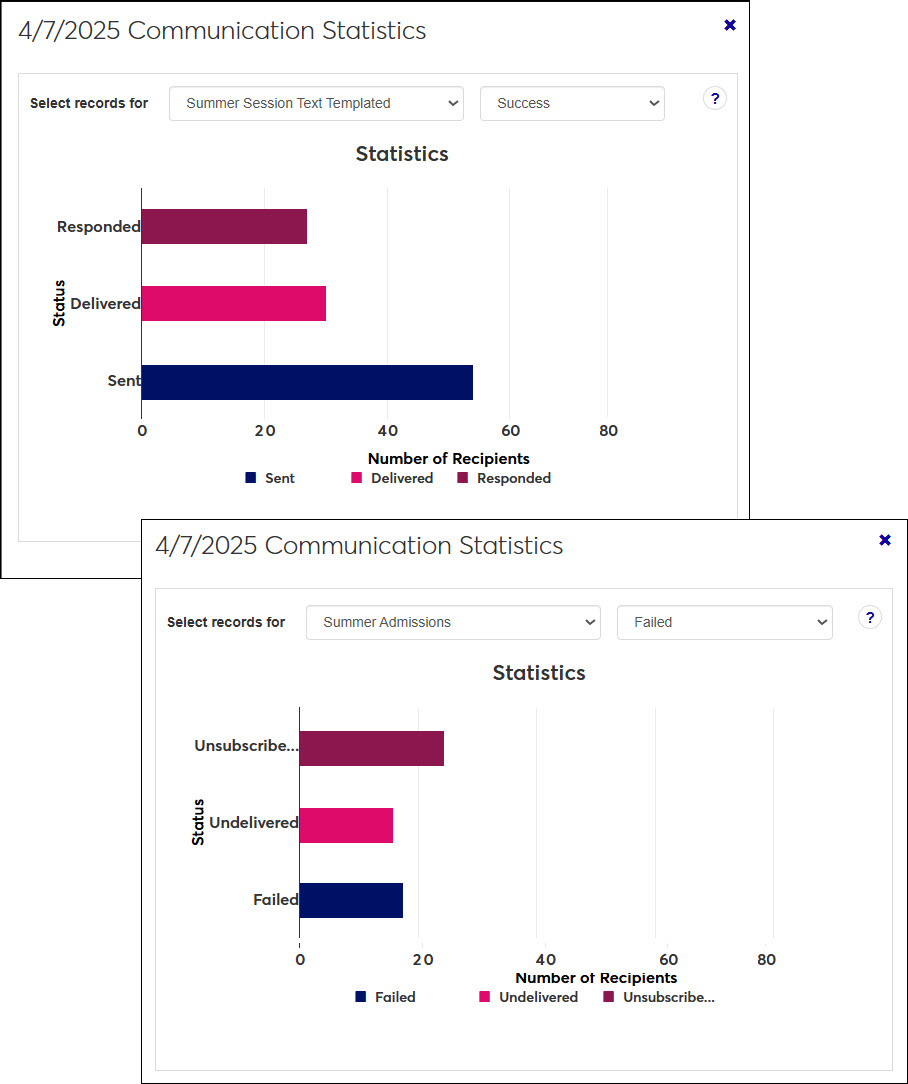 |
New Communication Preferences and Out of Office options are available with your General Settings preferences.
Communication Preferences settings let you customize your non templated outgoing emails with new Signature Tag options. You can add images such as logos, department and contact information, social media links, etc. to your personal email signature.
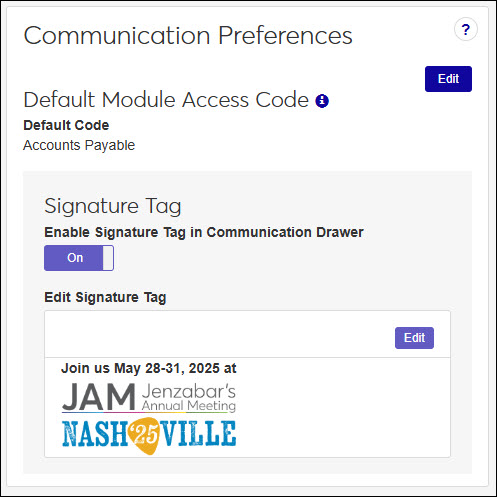 |
When you create your non templated email, your email signature automatically appears in your draft.
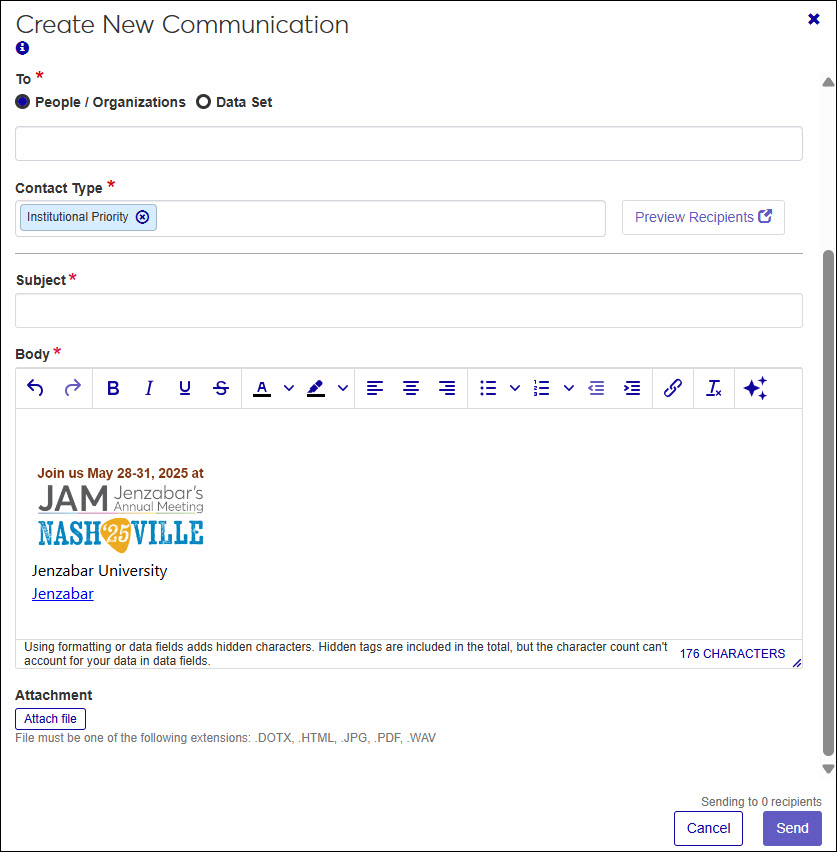 |
New Out of Office settings let you:
Pause interaction forwarding while you’re away.
Keep important tasks moving by automatically reassigning your To Dos while you're out of office.
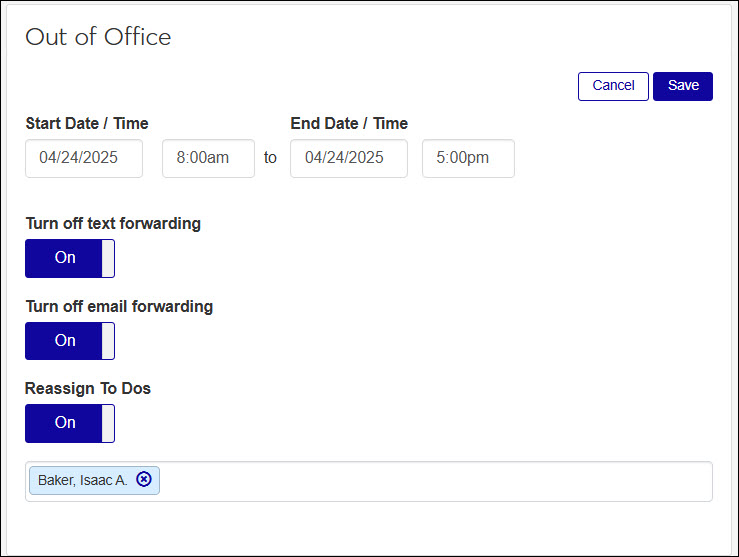 |
The Interaction Code, Name/Description field on the Create New Communication window has been moved up beside the Communication Type drop-down. when accessed from a specific entity page in the system, includes a new About field.
The Add, Edit, and Send options on the Interactions page previously opened new pages. Now, these options now open the Create New Communication for non-templated interactions, and the Add or Send windows for templated interactions.
Filter options on the Interaction Inventory page have been updated.
New Can view communication timeline permission is available with the Communication Management Licensed role.
*Available with Communications Plus.
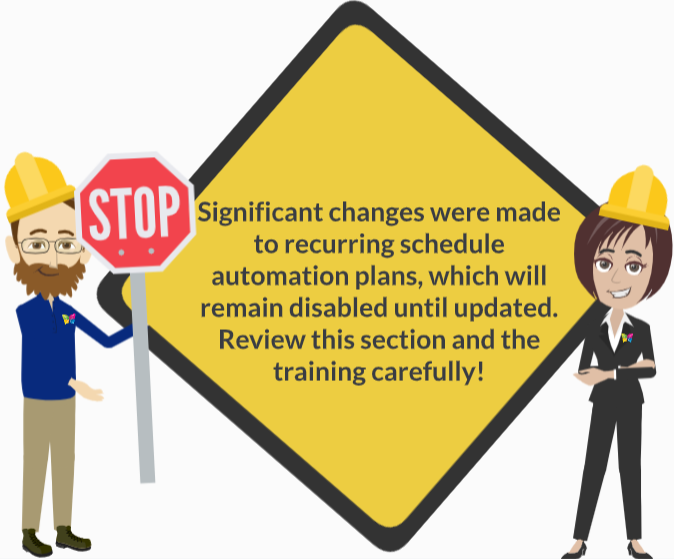
New Recipient Selection Process for Recurring Schedule Automation Plans
Warning
This section includes crucial information for schools with automation plans that use recurring schedules. Schools that only use kickoff dates and/or system events to initiate automation plans are not affected by these changes.
To simplify recipient selection for recurring schedule automation plans, newly qualifying recipients are no longer continuously evaluated and added throughout the plan's timeframe. Now, recipients are selected only when the recurring schedule begins to run. This means no additional recipients are added until the next time the plan runs again. As before, recipients who no longer meet the requirements to receive an interaction are removed immediately.
Recurring Schedule Plans Disabled After Upgrade
Note
Before updating recurring schedule automation plans, review the "Working with Automation Plans" course on learn.jenzabar.com. The "Automation Plan Recipient Options" section has been updated for 2024.1 to thoroughly detail these changes.
When the Jenzabar One 2024.1 upgrade is complete, all automation plans using recurring schedules are completely disabled. They will not run until they are evaluated, updated, and reactivated.
An indicator on the Automation Plans page shows which disabled plans need to be updated.

Use the Edit option and click Recipients to access the new advanced settings that need to be configured. These new settings, available when creating and updating automation plans, determine how recipients who previously received the plan are managed.
Note
Automation plans assigned to selected recipients are not impacted by the new advanced settings; they only need to be reactivated.
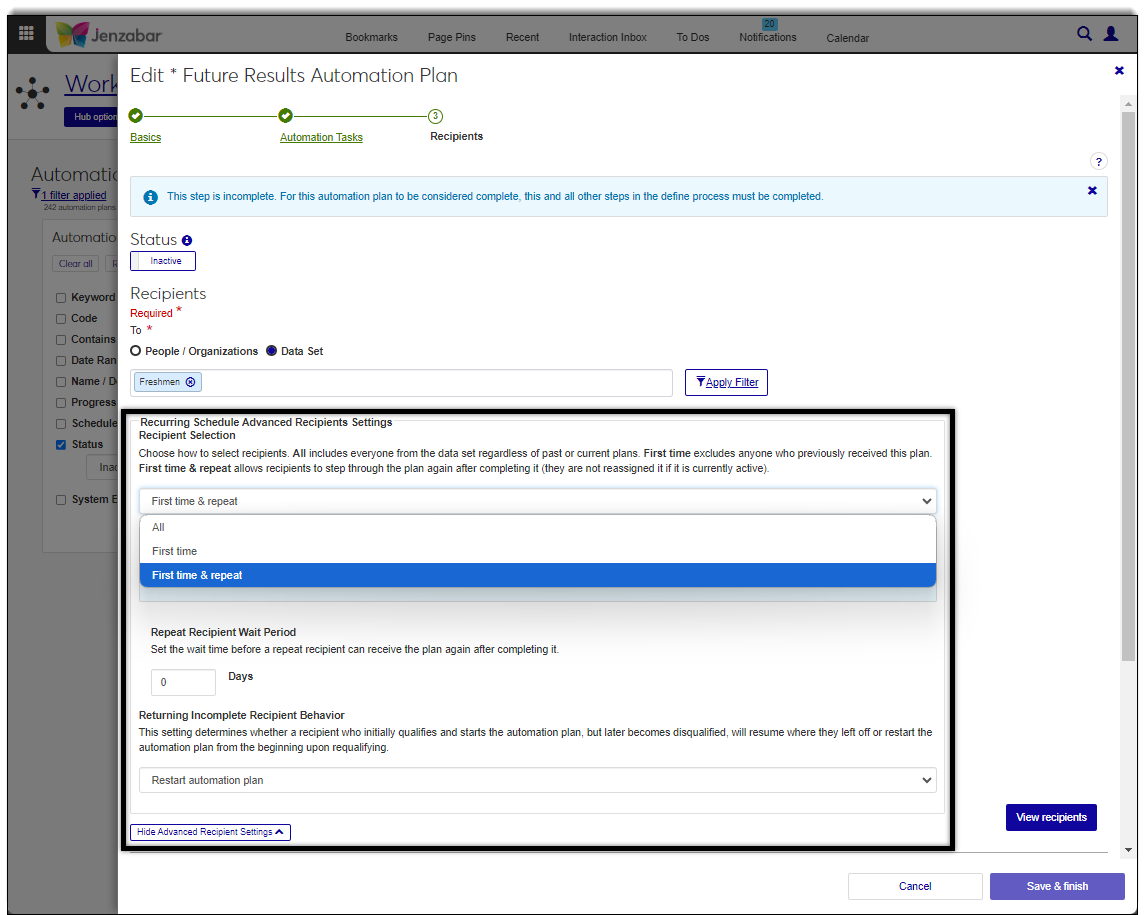
By default, plans are set to the new recipient option First time & repeat with no waiting period for restarting the plan for recipients who did not complete it previously. This means qualified recipients can follow the automation plan and, upon completion, become eligible to start it again on the next scheduled date.
Detailed information on the Edit page describes the new options.
To resume running the automation plan, update the Status to Active.
Removed Recipient Settings
The Last Date to Remove Recipients and Cutoff Date options are longer needed and have been removed from the Define and Edit Automation Plan, Add Recipients steps.
Create Workflow Automation Plans*
Workflow automation plans can now be created and initiated by a workflow to automate communications when certain conditions are met. For example, when a student completes an academic requirement stage, an automation plan can trigger notifications to the student's advisor and dean, start a long-running process classification update process, and send a congratulatory email to the student.
To create a workflow automation plan, select the new Workflow option from the Initiated By drop-down in the Define Automation Plan process, and complete the remaining setup as usual. Active workflow automation plans will then be available for selection when adding rules to workflow stage items.
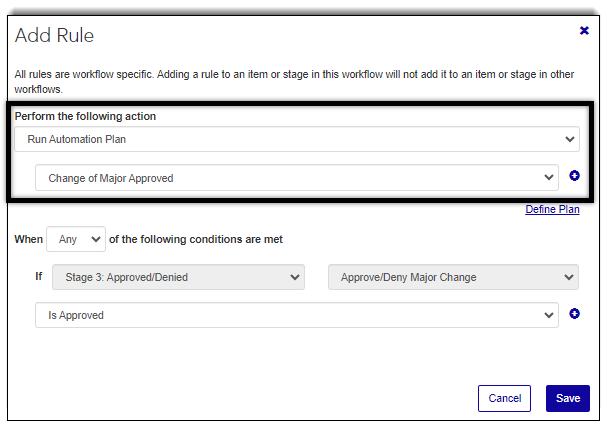
*Workflow Plus only.
Automation Plans Option Relocated
The Automation Plan hub option moved from the Communication Management hub options to the new Workflow hub options.
This means permissions to automation plans have also moved from the Communication Management Base role to the new Workflow Base role. Users that have or require permission to view, add, update, run, and delete automation plans must now be assigned to a Workflow Base role with those permissions enabled.
Effective September 30, 2024, Twilio began charging for failed message deliveries: Twilio's announcement about this change.
Unnecessary charges can be avoided by ensuring phone numbers in the system are up-to-date and verified accurately. To identify numbers that need review, Jenzabar created a Texting Contacts with Failed Statuses script. Work with your school's IT Administrator to download and run this script. Once the numbers needing review are identified, update them in the system as needed.
The contact import process is now part of the new Data Management feature. Communication contacts, previously imported using the Import Communication Contacts page, are now imported through the Import Processing Queue page in the new Data Management hub. This process still supports uploading multiple individuals and organizations at once from a .csv, .xls, or .xlsx file, with the option to preview contacts before importing.

A new step in the contact import process is associating a data mapping template with the file being uploaded. This template defines how imported contact data is mapped to specific tables and columns within Jenzabar One. Jenzabar provides a predefined Communications Contact Import data mapping template that schools can use during the import process, or schools can create and select a custom template of their own.
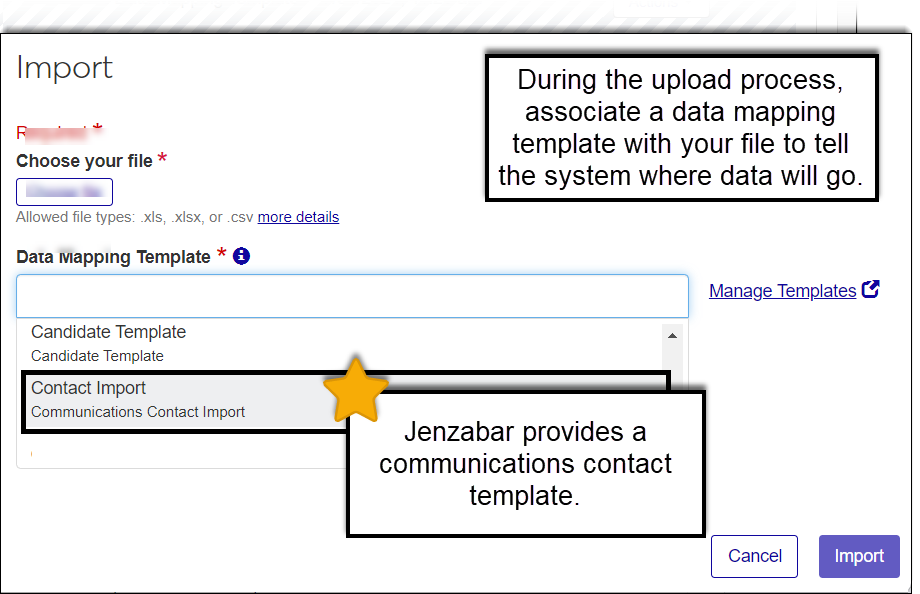 |
Like interactions, access to these new templates is controlled by module access codes. Users can only access the data mapping templates when they are in a role with permissions to specific access codes enabled. The Contact Import template is available to all users.
Notice
Permissions to the contact import process have moved from the Communication Management Base role to the new Data Management role. Users that have or require permission to import communication contacts must now be assigned to the Data Management role with that permission enabled.
The Schedules hub option moved from the Communication Communication Management hub options to the Campus-wide Definitions hub options.
This means permissions to schedules have also moved from the Communication Management Base role to the Campus-wide Definitions role. Users that have or require permission to view, add, update, and delete schedules must now be assigned to a Campus-wide Definitions role with those permissions enabled.
A new "Create Communication" toolbar icon lets users create communications from anywhere in the system.
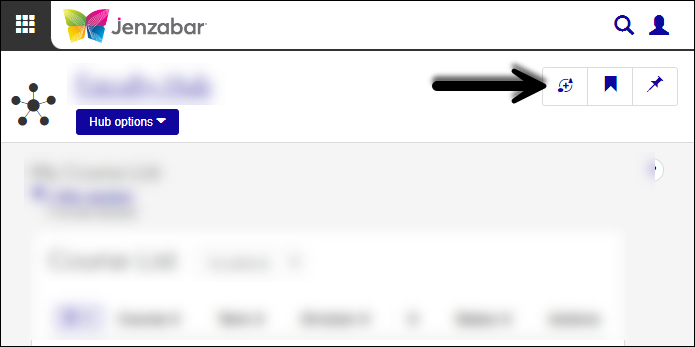
Note
New permissions are not needed to access the new “Create Communication” toolbar icon.
Multiple changes were made to the interaction inventory, feed, and inboxes to enhance performance.
Interaction Inventory:
Access Code and My Mentions filters were removed.
Name / Description column was updated to show the interaction's name, description, and code information. This consolidation eliminates the need for a separate Code column.
Type column was removed.
Interactions with attachments no longer provide a direct link to the attachment files on the main Interaction Inventory page. Interactions must be opened to access the attachments.
Interactions with multiple attachments no longer provide a count on the main Interaction Inventory page. Interactions must be opened to view the number of attachments.
Interaction Feed:
Interactions with multiple attachments no longer show the attachment count on the main feed. To see the number of attachments associated with an interaction, it must be opened.
Interaction Inboxes:
Filter option changes:
New Name, Email, and Phone filters were added. These filters replace the Name & Email and Name & Text Number filters to make searching by those criteria easier.
Access Code, Messages with Attachments to be Deleted, My Mentions, and My Read / Unread Comments filters were removed.
Interactions with multiple attachments no longer provide a count in the main Interaction Inbox, My Inbox, or Shared Inbox pages. Interactions must be opened to view the number of attachments.
2023.3
Updates to Interaction Sets
Naming changes:
Interaction Sets are now called Automation Plans.
"Add Interactions" step of the Define Automation Plan process is now called "Add Automation Tasks."
"Add Interactions to Set" now "Add Automation Tasks to Automation Plan."
Selecting a recurring schedule is no longer a separate step in the define automation plan process. You can now select it during the Automation Tasks step when you select the tasks/ interactions that will be added to the automation plan.
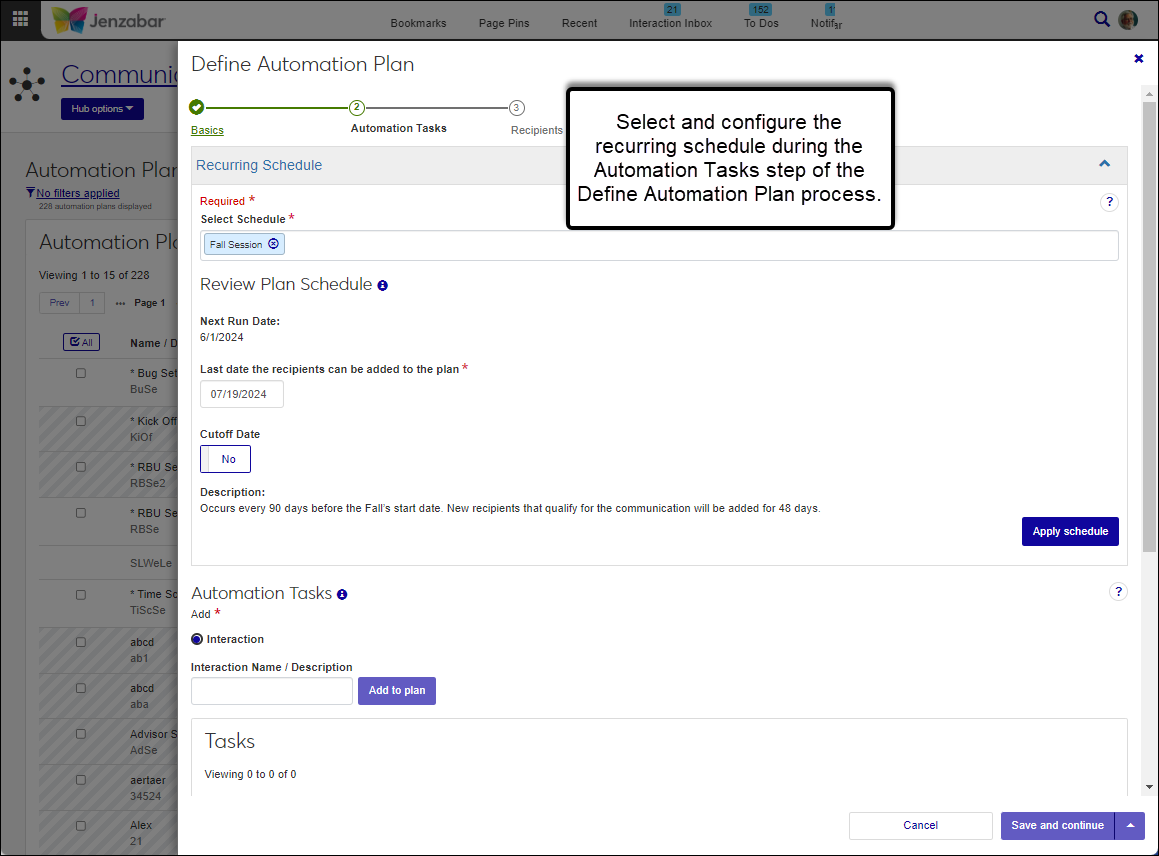
Instead of having two separate locations to define automation plans (previously interaction sets), you can now only define them from the Automation Plans page. Click Define automation plan to step through the process in a pop-up window as opposed to a separate page.
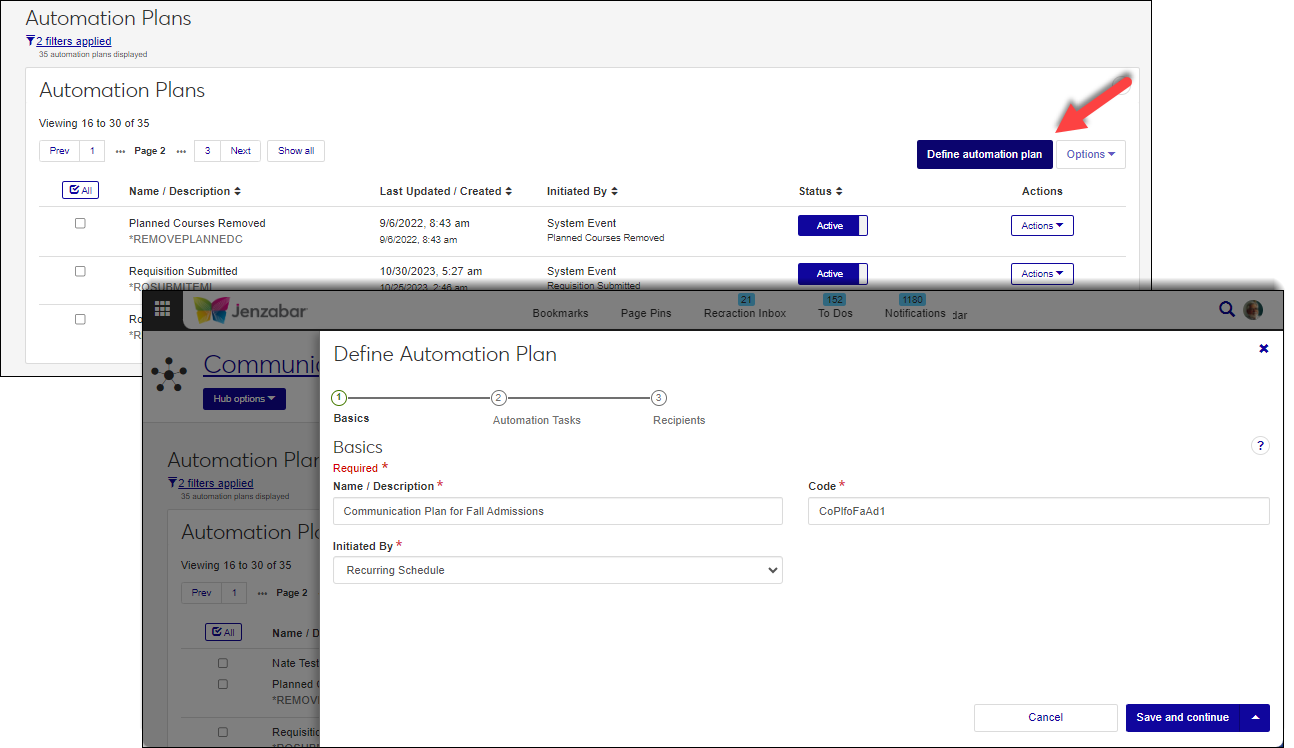
New date and time options let you specify exactly when the interactions in the automation plan will be sent/applied during the Automation Tasks step.
Automation plans with a recurring schedule include a new time option.
Automation plans with a kickoff date include new date and time options.
When selecting and reviewing the interactions included in an automation plan, new icons indicate the interaction type (for example, email or text).
You can now choose a cutoff date for a recurring plan. This date lets you specify when the interaction plan will no longer run and send communications.

Changes to Defining and Sending Interactions
Naming changes:
"Standard" interactions are now called "Templated" interactions
"Communication drawer" interactions are now called "Non-Templated" Interactions
Templated interactions (previously standard interactons) can now be sent from the Create New Communication window. This lets you leverage more robust formatting and placeholder text. For example, you can select an email with an associated HTML file that includes field replacer text. A new preview option lets you see the interaction in the way your recipients will see it.
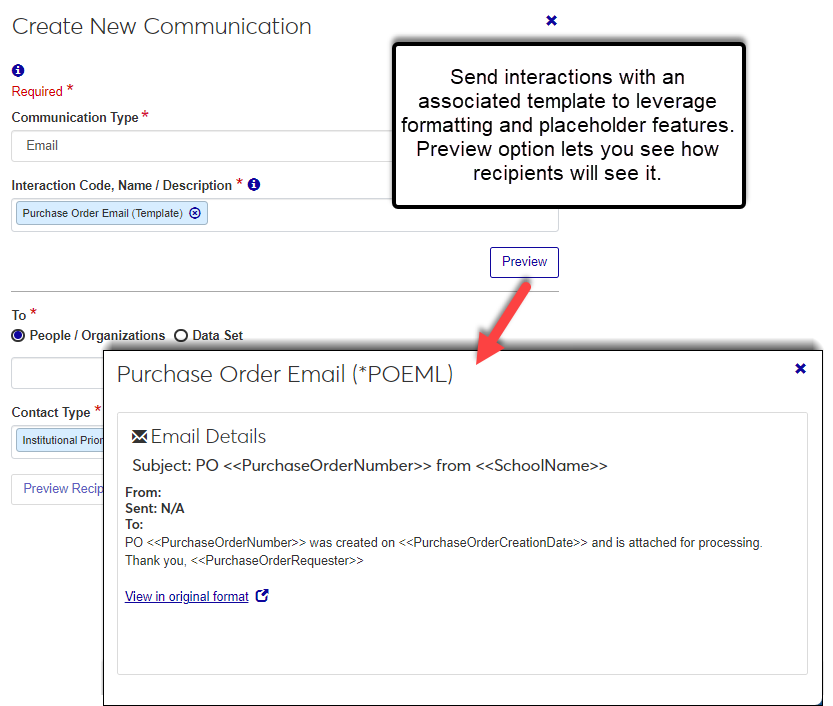
Additional Updates:
Integration with Jenzabar Financial Aid lets you leverage financial aid information to tailor communication content and determine interaction recipients. For example, a document interaction can include information about a prospective student's financial aid award or you can email just those students who need to complete their financial aid paperwork.
Information about an interaction can now be shown visually on the Interaction Detail page.
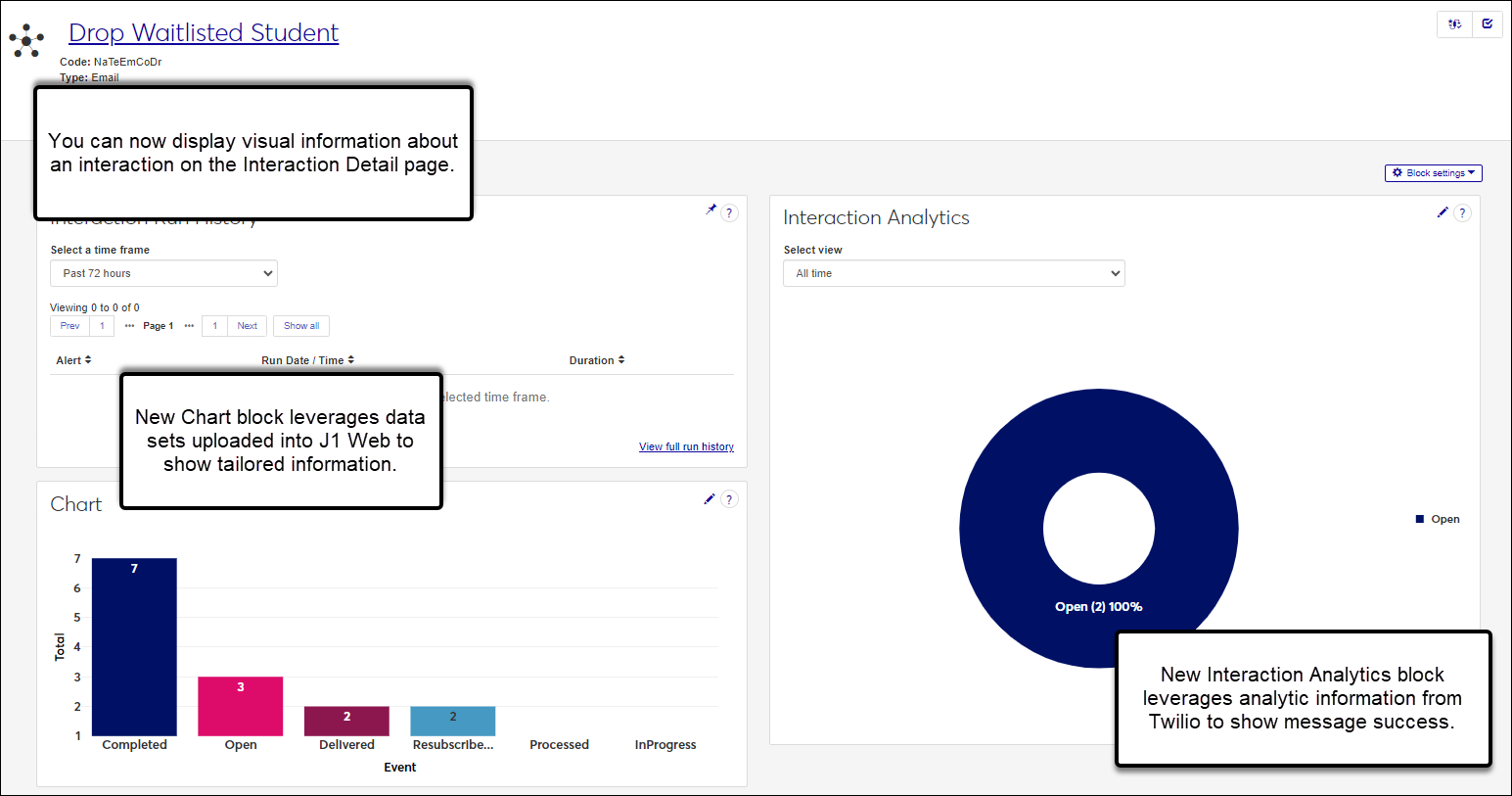
The new Interaction Analytics block leverages analytic information from Twilio to show message success and the new Chart block lets you use data sets uploaded into J1 Web to show information in your system.
Tip
The chart block can be used on any page with block setting options. For example, the Communication Management Summary page.
Note
Users can only see the information they have permission to access.
A new Disable Outbound Communications setting in System Administration, Communications lets you disable sending communications while your school works in test environments.

New indicators and options let you identify and handle emails received from unknown senders. You can add them as a permanent record or, if they already exist in the system, associate them with the relevant record. You can also create a new conversation thread, allowing you to link the email with an interaction code and preserve the conversation with the sender.

New indicators on the email and text detail windows more clearly show when a recipient has unsubscribed from receiving emails and texts.
Performance improvements were made to the interaction inventory and feed.
New Data Set List Block
Data set results can now be shown in a Data Sets List block on the Communication Management Hub page. Information can include anything in your system captured by a simple query and uploaded into J1 Web as a data set. For example, you can display a list of all available courses, recipients with missing or invalid contact information, enrolled students graduating in the upcoming term, etc.
Information is dynamic, which means users always see the latest and most accurate information.
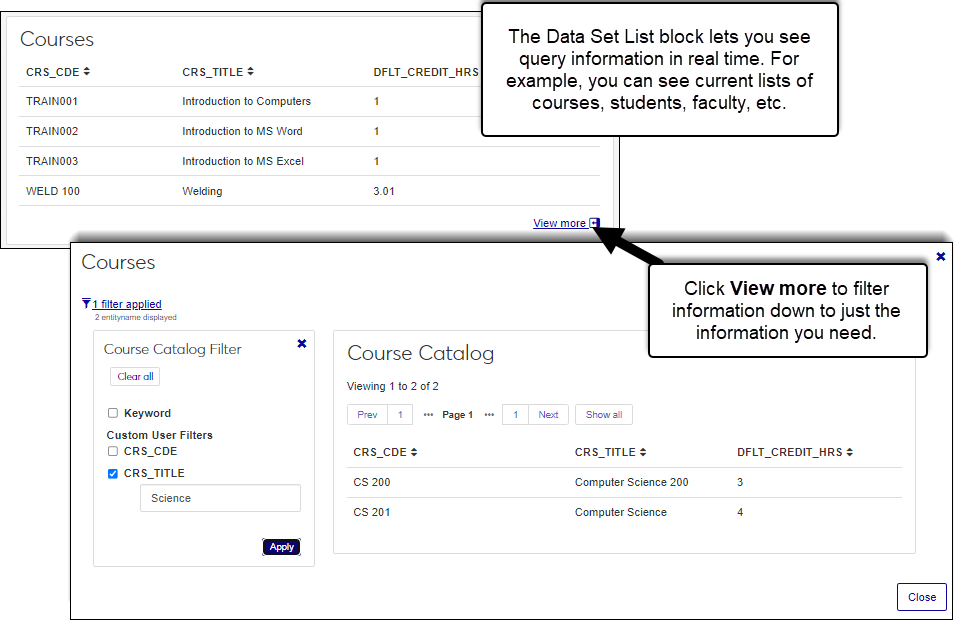 |
The Data Set List block supports HTML formatting, allowing you to link to additional information from the columns.
Note
To add a Data Set List block to the Communication Management Hub page, a user must belong to a Communication Management Base role with the Can manage blocks permission enabled. The user setting up the block will only be able to select data sets they can access.
To view the Data Set List block, users must belong to the Communication Management Base role.
Tip
The Data Set List block will be available in other hubs in upcoming releases. Schools using Registration will be able to add blocks with information about students and enrollment, and those using Finance will be able to add blocks with information about purchase orders or delinquent accounts.
Additional Resource:
Introducing Calling Features*
With 2023.1, users licensed for Communications Plus can now make and receive phone calls from J1 Web.
Incoming Calls
When a call comes into a Twilio number and is forwarded to another number such as a cell phone or desk phone, an incoming call notification appears on your screen with options to view known information about the caller and answer the call.
Once you answer, you can record the call and assign it an interaction code to save the conversation in the system for reference.
Note
Jenzabar recommends notifying individuals when calls are being recorded as a best practice and to ensure compliance with Federal Communications Commission (FCC) recording regulations in states where notification is required. Jenzabar provides a general script when you access recording options.
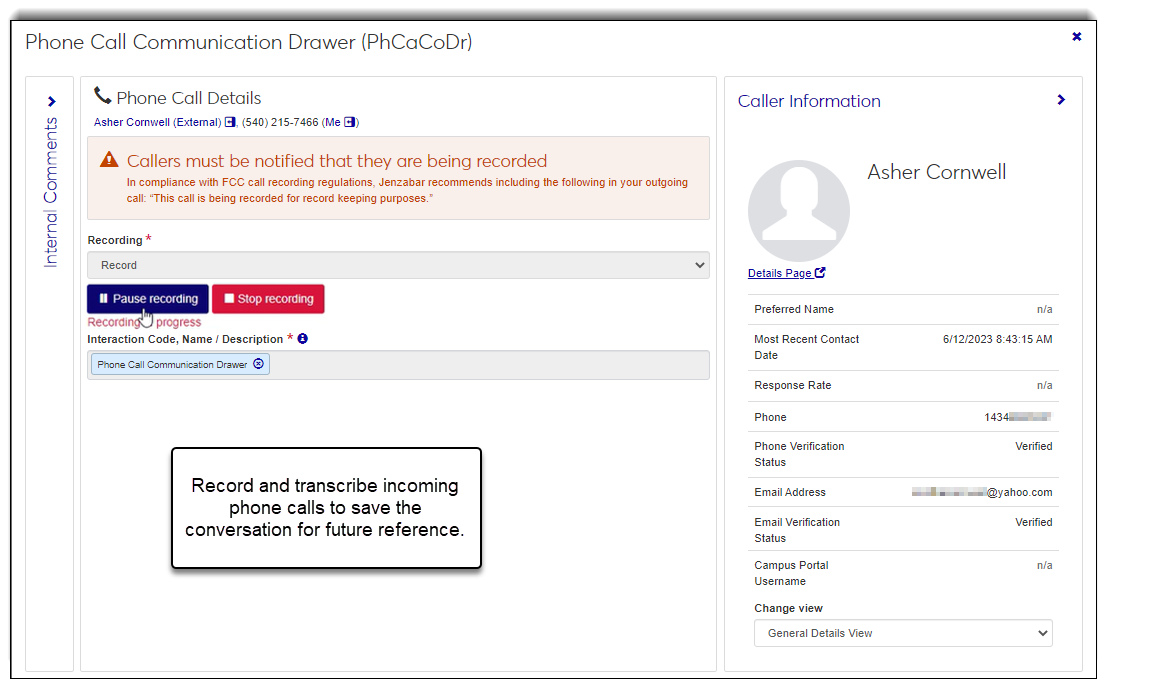
Outgoing Calls
Outgoing calls can be made across the system from the Create New Communication window and your To Do List. Phone calls let you communicate directly with individuals and have those conversations documented in the system.
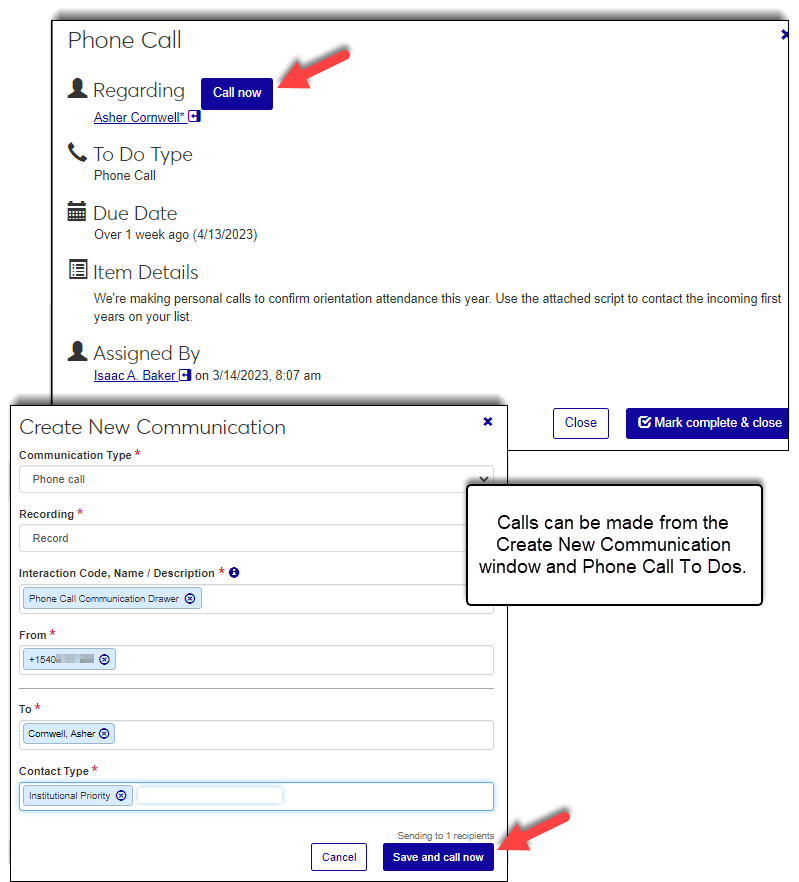
Accessing Calls
Recorded calls appear in the Interaction Inventory and Feed, and if you are the person who answered the call, your Interaction Inbox as well.
You and others with access to the phone call's interaction code can review and add comments and include @mentions to collaborate on follow-up items.
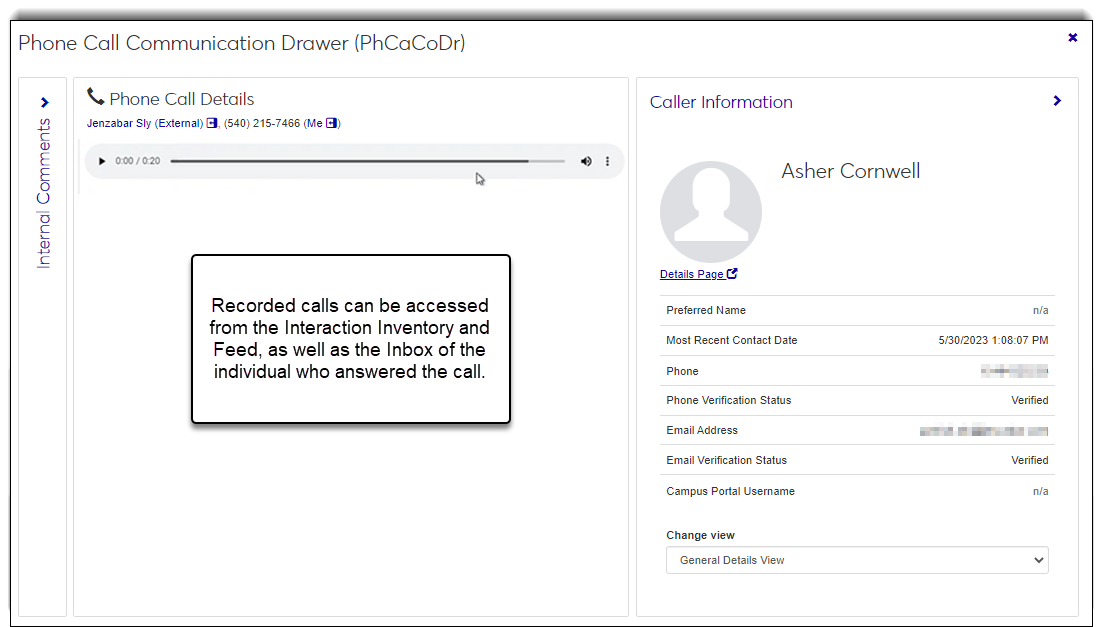
Note
To work with phone calls in the system:
Users must be assigned to a voice-enabled Twilio number with call forwarding configured in Jenzabar One Web. For more information, see the Communications Management Settings: Phone Numbers help topic.
Users must belong to a role with access to phone call/To Do phone call interactions.
Roles are granted module access on the Edit System Role page. Module access is granted when defining phone call and To Do phone call interactions.
*Available with Communications Plus.
Create Interaction Sets and Preview Templates from the Interactions Page
Create Interaction Sets
A new "Create a new set" option has been added to the Interactions page to make creating interaction sets faster and easier. Access the Interactions page, select the interactions you want included in the set, and then select Create a new set from the Options drop-down to access the Define Set process.
Note
Only active, standard, and system event interactions can be added to a set.
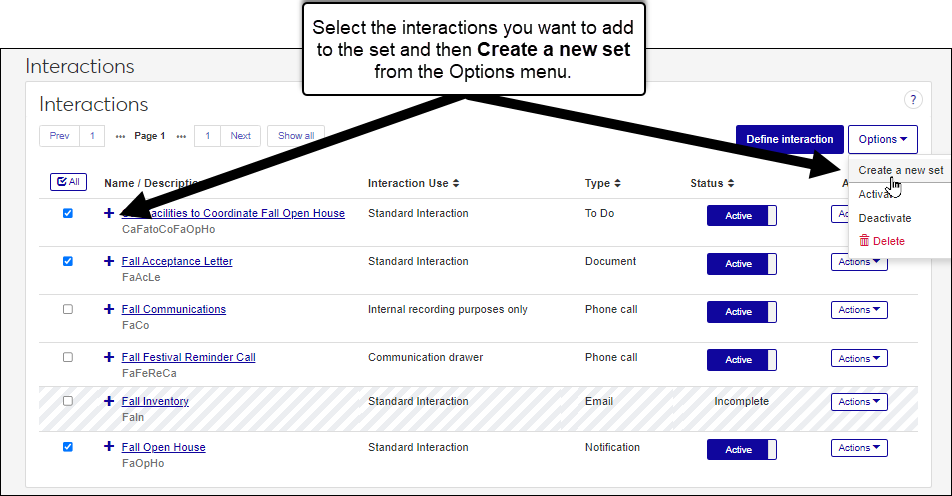 |
When you arrive at the Add Interactions step, the interactions you selected are shown. You can tailor the order, days to delay sending, add more interactions, and create any needed rules.
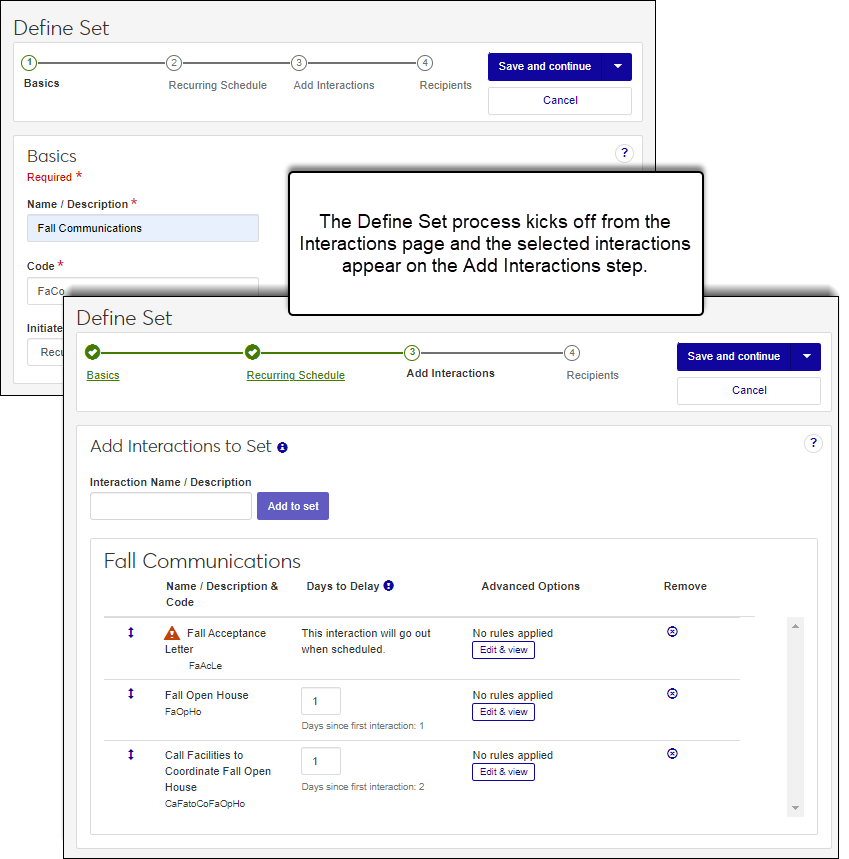 |
Once you complete the Define Set process, your new interaction set is active and can be viewed on the Interaction Sets page.
Note
To create an interaction set from the Interactions page, a user must belong to a Communication Base role with the Can create interaction sets permission enabled.
Preview the Interaction
A new "Preview template" option on the Interactions page lets you see how an interaction will appear to its recipients.
Note
Only active, standard, and system event interactions can be previewed.

Note
To preview the interaction, users must belong to a Communication Management Base role with the Can view interactions permission enabled.
Embed Links to FormFlow Forms in Interactions
Links to FormFlow forms can now be added during the define email, note, and text interaction process. For example, you can set up a housing information email that includes a link to your school's housing application or a text requesting updated contact information with a link to a student information form.
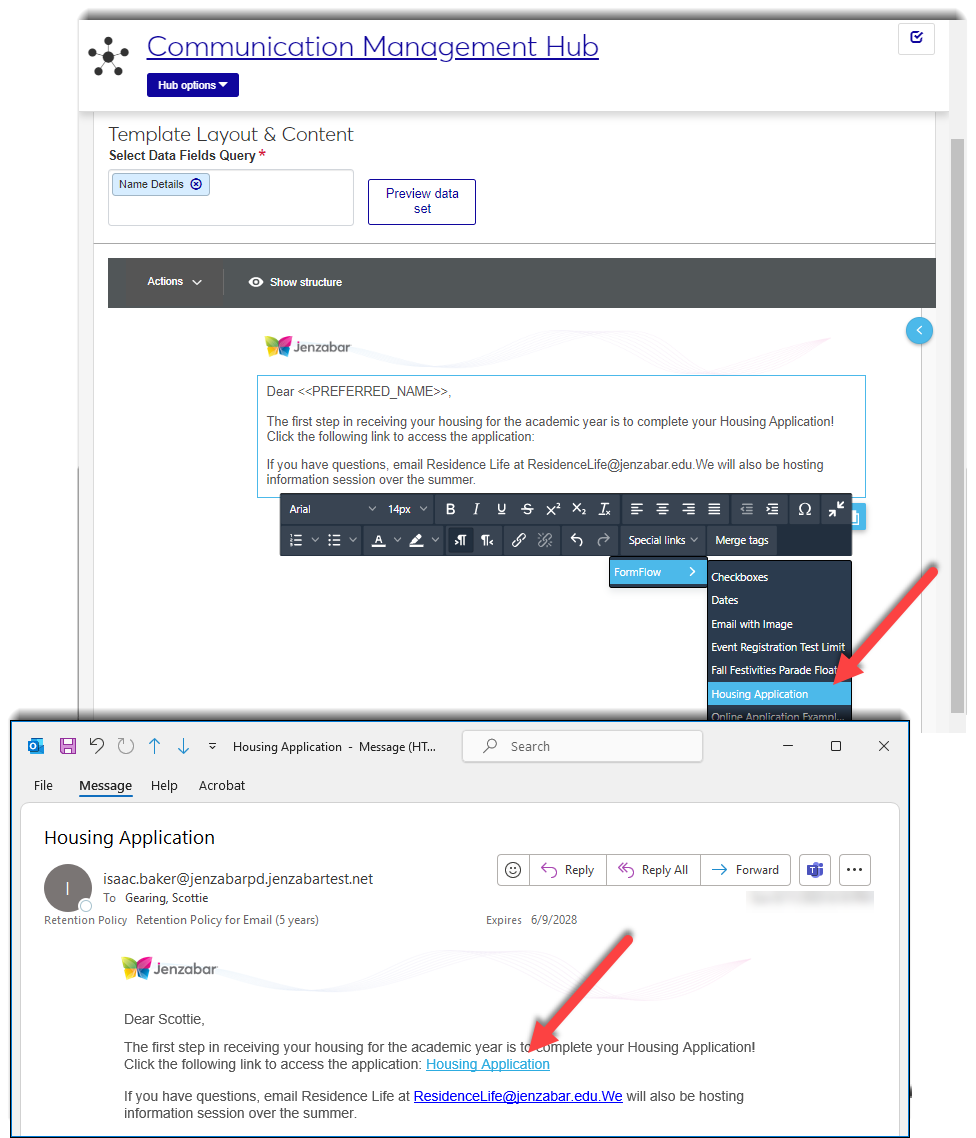
Note
Unique Jenzabar One Web permissions are not needed. Users that belong to the Communication Management Base role with the Can add or edit interactions permission enabled and permission to FormFlow - Forms can insert links to forms.
Campus Portal site address must be entered in the JICS URL field (System Administration, System Settings, Product Installs and Sign In page).
FormFlow form links cannot be added to Chatbot, document, notification, phone call, and To Do interactions.
New SendGrid Email Provider Configuration
Schools using SendGrid as their email provider can now enter their Webhook password in System Administration, System Settings, Communications, Email Provider.
For existing customers that do not have this password established, J1 Web will generate one for you when you first start up the system after upgrading to 2023.1. The system will also automatically update SendGrid with the new password.
New customers will get this password and enter it in the J1 Web, System Settings, Communications, Email Provider section when they configure SendGrid.
Interaction Access Now Module Access
Interaction Access tab on the Edit Roles page is now called "Module Access." The tab is used in the same way - to control access to different interactions when they are defined and applied. Jenzabar provides module access codes based on Jenzabar modules, and you can create custom ones on the Access Codes page. Users that belong to multiple roles will have access to the interactions available with each.
Issue | Description |
|---|---|
RN37768 | In some cases, the comments drawer did not load on the first attempt. |
RN43643 | The Interaction Use column displayed twice on the Interactions list. |
RN43755 | Opening a Chatbot drawer resulted in a browser console error. |
RN43886 | The Split thread function had accessibility issues. |
RN44422 | A file upload with the same name resulted in an error instead of replacing the existing file. |
RN44426 | When merging threads, the "Last read" indicator displayed inside a text bubble instead of above it. |
RN44429 | In the Shared Inbox, the Interaction Code filter did not return rows properly. |
RN46170 | Unsubscribe requests were not being unsubscribed. |
RN46701 | When there was initially a problem sending an email, but it ultimately succeeded, an error still showed in the Interaction Details drawer. |
RN46866 | The link to an interaction from the To Do list did not properly load the page. |
RN47216 | When uploading a data set with more than 8,000 characters, the user received an error. |
RN47327 | Interaction sets with multiple rules evaluated all rules even if a one rule indicated the interaction should be skipped. |
RN47697 | When launching the Communication Drawer from a person's details drawer, the recipient's "To" address was not automatically populated. |
RN47906 | When defining an interaction, the code input was being overwritten when the description was changed. |
RN48107 | Attempting to delete a comment where someone has been mentioned resulted in an error. |
RN48189 | Interaction Sets with Days to Delay set was not always honoring the delay when a new recipient was added to the set. |
RN48420 | The initial start date of a set was not being consistently reported between the summary drawer and the wizard. |
RN48578 | Text interactions showed the wrong first line in the inbox preview after a merge was completed. |
RN48639 | When the pop-up drawer was opened, it incorrectly disabled the expand button in the header. |
RN48689 | The Unknown Email code displayed as an option in the drawer when it should not have. |
RN48741 | The subject line displayed twice in an email window for Communications Base clients. |
RN48745 | A loading error occurred on the Communication Contacts page when no data sets were available. |
RN48790 | Access codes did not sort alphabetically for unrestricted users. |
RN49119 | Users received a loading error on the Interaction Inbox. |
RN49295 | When copying an interaction, the Interaction Use field always displayed as "Standard Interaction." |
RN49357 | In some cases, a user received their own reply when responding to a text message via an external email application. |
RN49360 | Even though a recurring daily schedule had been created, it was not an option that could be selected when working with interaction sets. |
RN49361 | Initial setup of SendGrid as an email provider used all rows in APP_USER in determining who to assign emails to rather than only active web users. |
RN49362 | Some large Interaction Data Set queries produced an error and did not send emails. |
RN49573 | The "Select All" option on the Communication Contacts page only selected 15 people. |
RN49656 | An internal DDU build resulted in the data set preview not being able to load. |
RN49903 | Interaction sets with delayed delivery settings were not honored in some cases. |
RN50182 | Users could create schedules without selecting an end date or number of occurrences. |
RN50183 | Interaction emails did not display the designated From address, and instead displayed the email address of the user who set up the interaction. |
RN50186 | When Chatbot responded to a message, the row in the inbox did not show who the original message was from. |
RN50244 | The Configuration Status block incorrectly displayed a message that SendGrid MX records were not configured correctly even when they had been. |
RN50462 | A performance issue caused phone call errors. |
RN50501 | When a poorly performing data set was used, it caused future interactions to be scheduled later than intended. |
RN50506 | When an error occurred with one recipient in an interaction, additional recipients didn't receive the communication. |
RN50509 | When an interaction took a long time to complete, the next delayed interaction used the completed run time as its run time instead of the time it was originally scheduled to be sent. |
RN51127 | When copying an interaction, the success alert did not display until the user navigated to a different page. |
RN51144 | We improved the loading time for the Interaction Inventory. |
RN51145 | There were performance issues with the Interaction Inventory page. |
RN51372 | The "sent by" name was incorrect in some email views. |
RN51483 | Users in Communications roles were able to convert external persons to internal without being members of the External Person Management role. |
RN52291 | Interaction Inbox showed user was responding to an email message when it should only show when responding to text messages. |
RN52425 | Some of the default data sets did not display for users who had permission to see them. |
RN52774 | Attachments permissions for documents aren't honored in Communications. |
RN52998 | When setting SendGrid as the email provider, the API key did not save. |
RN53394 | When attempting to import the same source, duplicate key messages were encountered. |
RN53517 | In some cases when a user responded to a text message instead of to the Chatbot question, Chatbot stopped responding. |
RN53685 | The save and continue button was disabled when navigating back in the wizard. |
Chatbot Integration*
*Available with Communications Plus
Overview
Jenzabar's Chatbot can now be integrated with J1 Web Communications. Schools can import Chatbot conversations into J1 Web for a read-only view and leverage Chatbot to reply to incoming text messages.
Note
Chatbot conversations are imported an hour after an exchange has occurred. They are not immediately imported.
Imported conversations let you view transcripts of the Chatbot exchange in the Interaction Inventory, Inbox, and Feed. These conversations are identified with a new Chatbot icon  .
.
Note
J1 Web users cannot reply to imported conversations. Requests for human intervention in imported conversations are handled outside of J1 Web. You could use comments to tag a J1 Web user and confirm the individual received a response.
Including Chatbot threads in J1 Web gives you a comprehensive view of all exchanges with a constituent and provides opportunities for additional engagement. You can gauge interest in different things or follow up on questions. If the individual asks several questions across different areas, you'll have an opportunity to split the thread and assign different questions to the appropriate areas ensuring the right J1 Web users can see the exchange.
Just like texts and emails, you can add comments and tag other J1 Web users to bring threads to their attention.
Note
Chatbot must be set up to collect the individual's name and email address so the thread can be associated with them and imported into J1 Web.
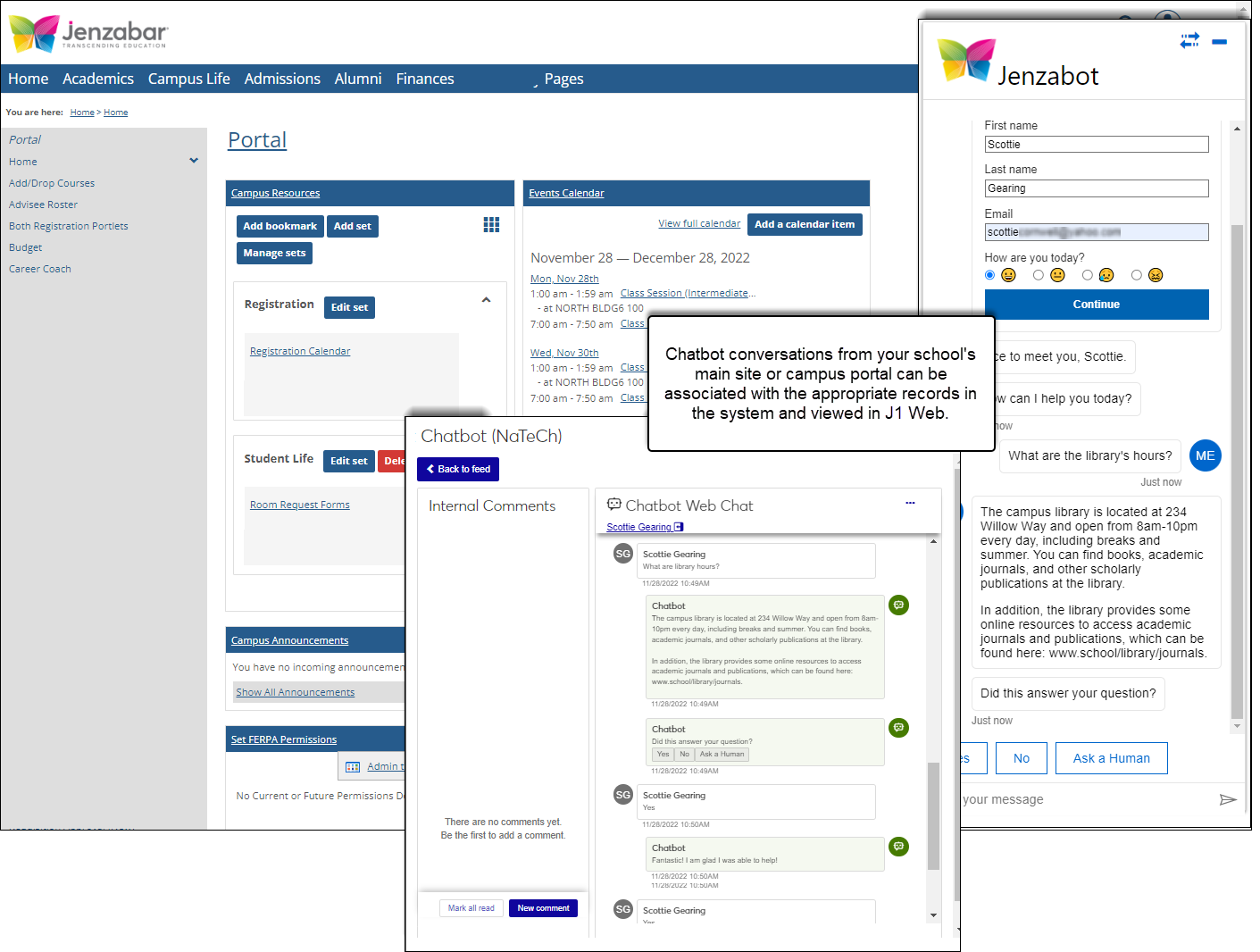
You can also leverage Chatbot's knowledge base to reply to incoming text messages. This can be helpful if you have a common number that receives a high volume of general questions. For example, a number shared by your registration department that receives a high number of questions about registration time frames. Phone numbers with Chatbot enabled show a new Chatbot icon  .
.
If Chatbot cannot answer the incoming question, individuals assigned to the number receive a 'Chatbot Assistance Required' notification and see error icons  . Anyone assigned to the number can reply and because these are text threads, when more than one user is assigned to the number, the conversation is locked to the person responding to prevent overlap.
. Anyone assigned to the number can reply and because these are text threads, when more than one user is assigned to the number, the conversation is locked to the person responding to prevent overlap.
When closing out the response, you will see new options to disable or reenable the Chatbot for any additional text exchanges with this thread. Reenabling means Chatbot will attempt to reply to any new messages within the same exchange and disabling means individuals assigned to the number will reply to any new messages within the same exchange.
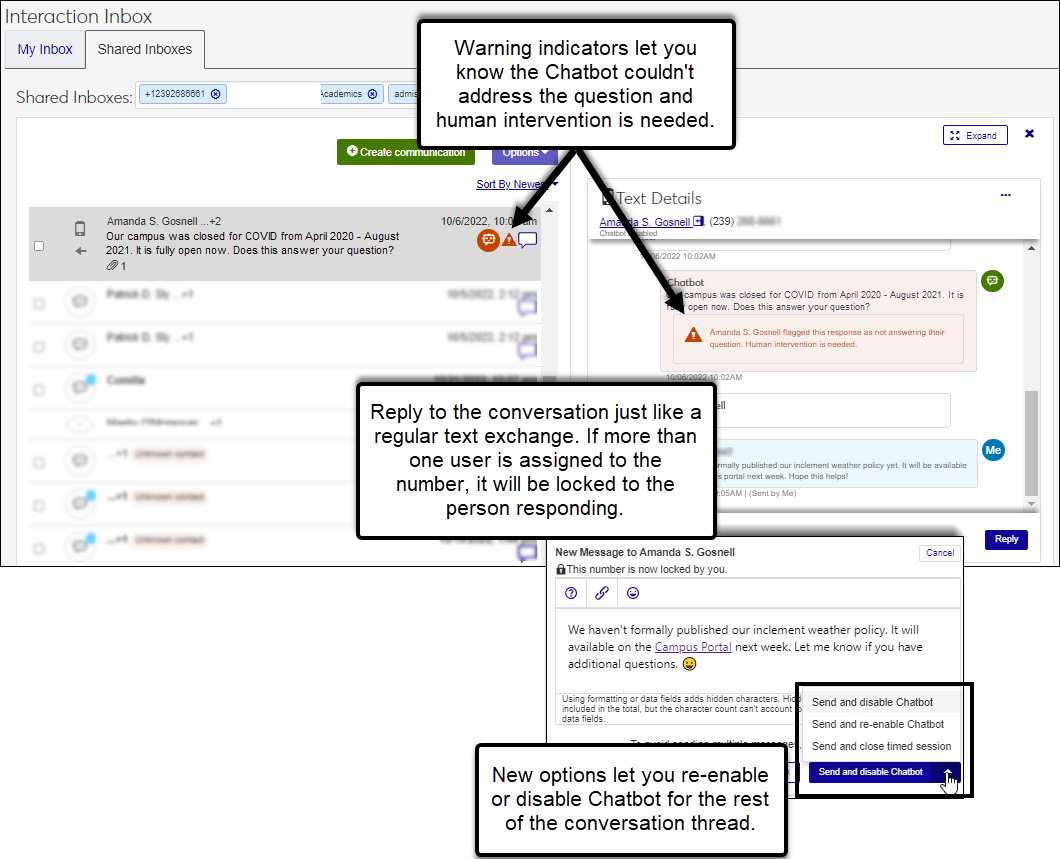
Just like imported Chatbot threads, you can view the full text exchange between Chatbot and the individual as well as any human intervention messages from the Interaction Inbox, Inventory, and Feed.
Chatbot Integration Setup
Establish a connection to the Chatbot using the new System Administration, Communications, Chatbot Integration setting. Your Chatbot URL and shared secret key are available from Jenzabar's Support team https://support.jenzabar.net/.

To allow Chatbot to reply to incoming texts:
Enable Chatbot using the new Manage Chatbot option on the Communication Settings page (Phone Numbers tab, Actions button, Manage Chatbot option) for the appropriate numbers.
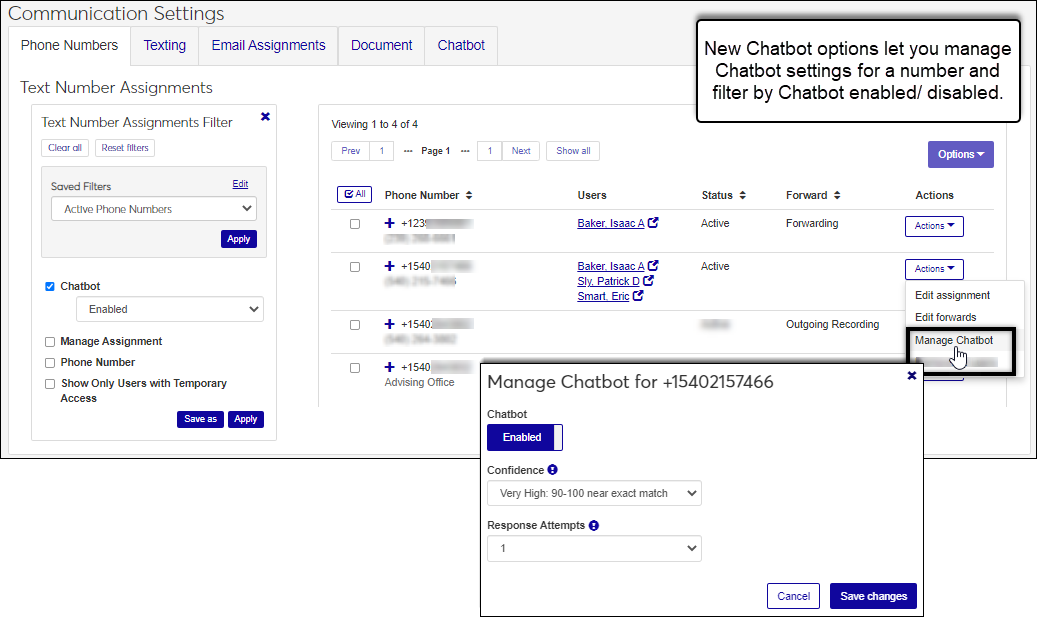
The Confidence and Response Attempts options let you determine when human intervention will be requested.
To enable importing:
Define Chatbot interactions that can be associated with Chatbot categories. Just like other interactions, access codes associated with the Chatbot interactions determine who can view the conversation. Create an interaction for each category you want to import.
Note
These interactions are for internal use only and cannot be sent individually or included in interaction sets.
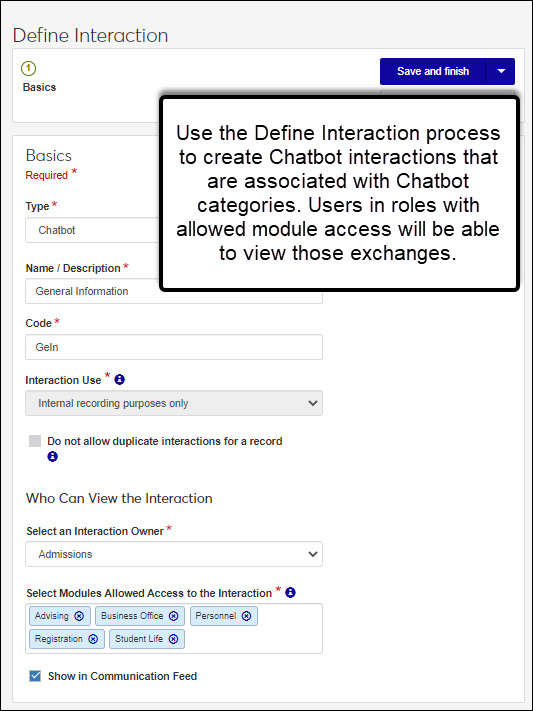
Assign the Chatbot interactions access codes and/or specific users to the appropriate Chatbot categories using the new Chatbot tab on the Communications Settings page. These access codes are assigned to the imported conversation automatically. If a Chatbot category is not assigned a Chatbot interaction, it is not imported.
Tip
Jenzabar recommends only importing relevant categories. For example, chitchat conversations may not need to be imported.
Specific individuals assigned to a Category will be able to review and evaluate incoming conversations from unknown individuals in the Interaction Inbox. Options will let them determine if it is a known individual and associate them with the appropriate record.
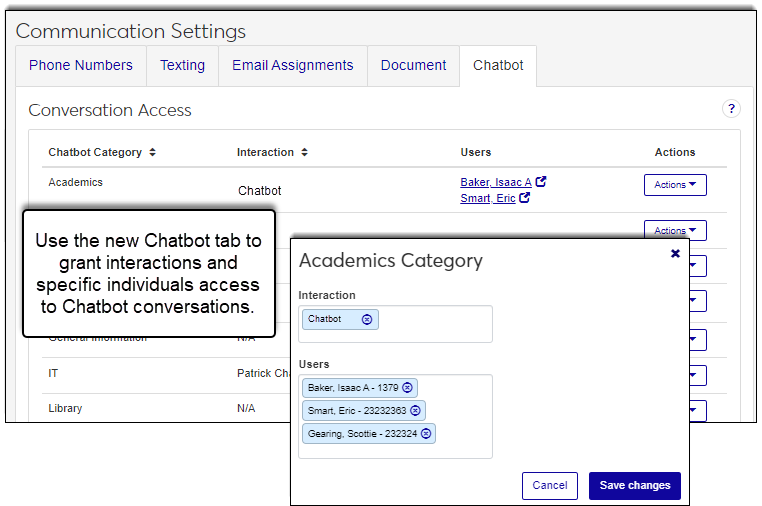
Note
Chatbot categories are managed in Chatbot. Work with your Chatbot administrator to ensure the correct categories are set up.
Ensure Chatbot is set up to collect identifying information (individual's name and email address). If information is not collected, the conversation is not imported into J1 Web because it cannot be associated appropriately.
Additional Resources
Chatbot eLearning Courses available from the Learning Portal
Chatbot Help Videos (credentials available through your Chatbot administrator)
Permissions
No new role permissions are needed. Users in a Communication Management Licensed role can enable Chatbot for phone numbers, assign Chatbot interactions/users to Chatbot categories, and view Chatbot threads in the interaction inbox, inventory, and feed.
New Import Contacts Feature
The new Import Communication Contacts page lets you bulk import external persons/contacts that can be used for recipient lists. The system accepts .xsl, .xslx, and .csv files that include last name, first name, address, city, state, zip, address code, alternate contact type, email address, phone number. and phone type.
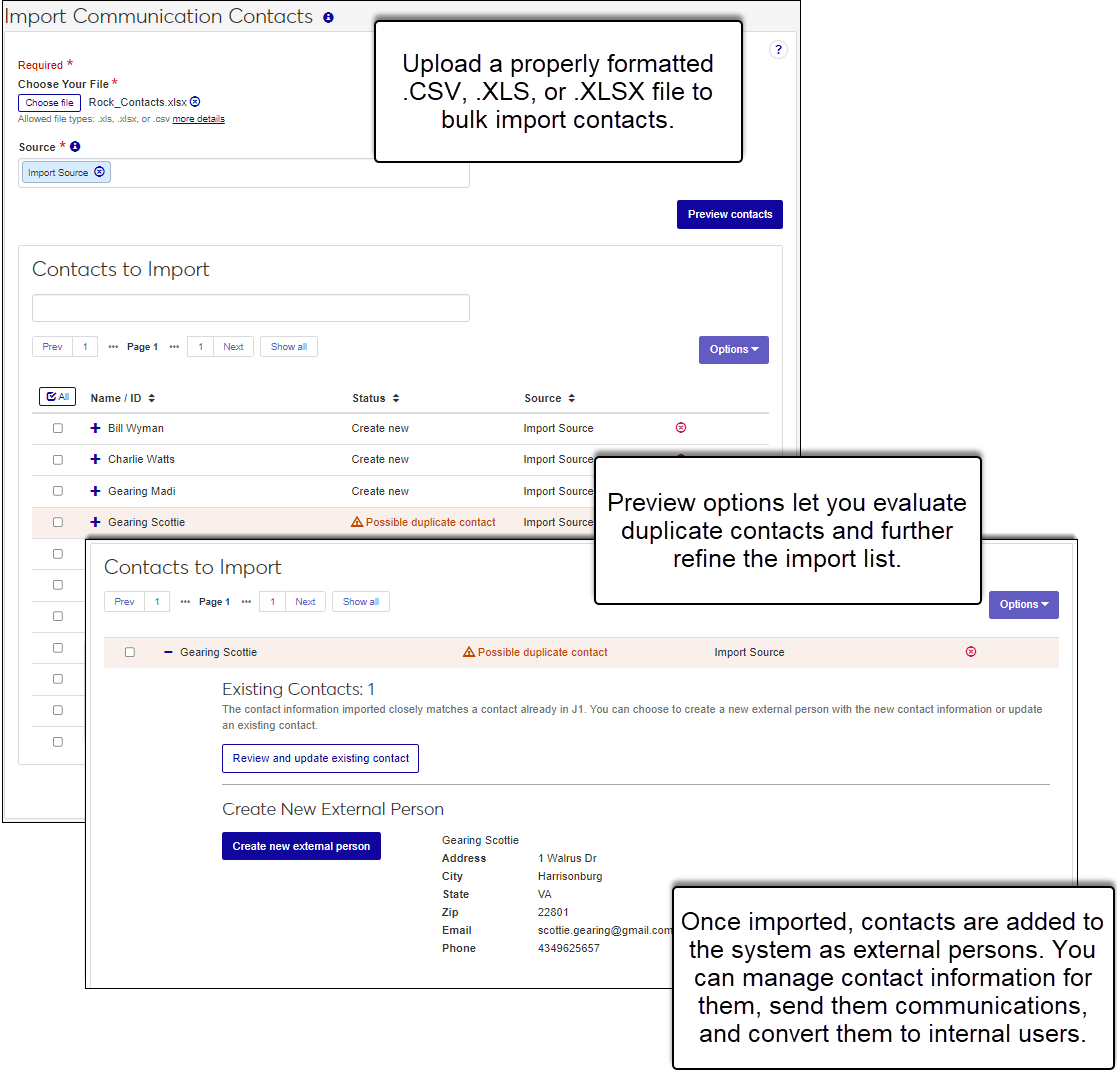
You can use the preview option to verify the list the list of contacts to be imported and resolve potential duplicate records. Imported contacts are added as external persons. You can manage their contact information, send them communications, and convert them to internal users with ID Numbers.
Imported contacts can also be used as data sets for targeting recipient groups.
Note
To use this feature, users must belong to a Communication Base role with the Can import communication contacts permission enabled.
New Configuration Status Block
The new Configuration Status block on the Communication Management Hub page shows the status of Communications settings. It identifies issues and links to help topics with troubleshooting information. You can see configuration information for system settings, SendGrid and Twilio settings, and data sets.

Note
To use this feature, users must belong to a Communication Base role with the Can view Configuration Status block permission enabled.
New Custom Content Block Options
New Block settings options let module managers add custom content blocks and manage Jenzabar-provided blocks on the Communication Management Hub page. Once you add a custom content block, use the edit options to add content, links, and images. An accessibility checker is included to ensure content meets accessibility guidelines.
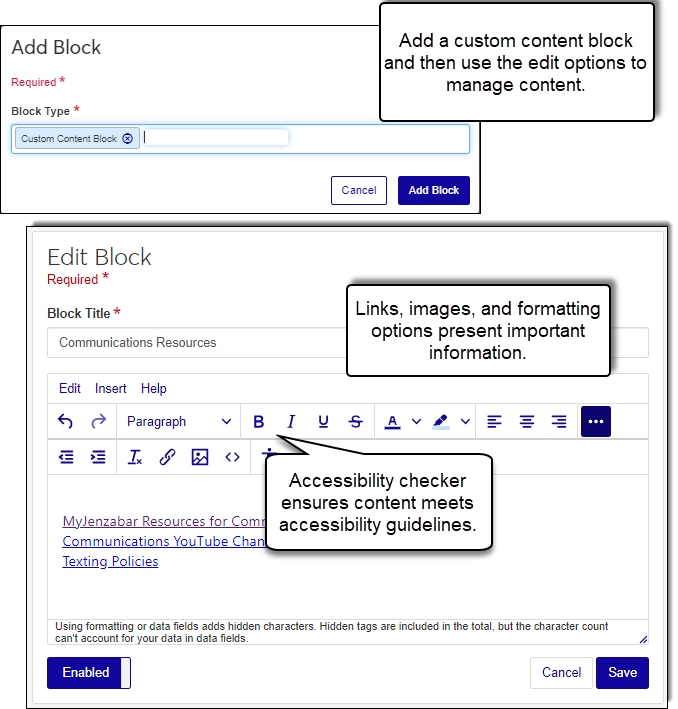
The Manage Blocks options let you order, enable/disable, and permanently remove hub blocks.
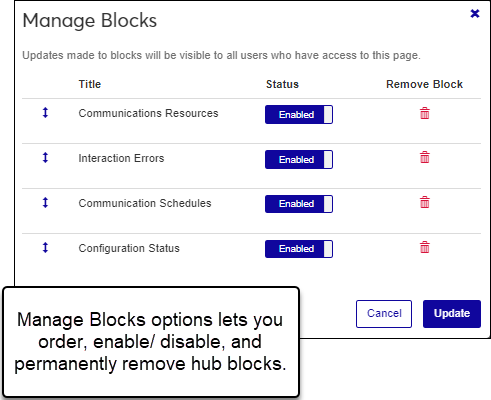
Note
To use this feature, users must belong to a Communication Base role with the Can manage blocks permission enabled.
Create Contacts from the Communication Contacts Page
You can now manually add contacts from the Communication Contacts page. A new Create Contact button accesses the Create Contact window that steps you through the process of adding an individual to the system as an external person.
To add an external person to the system, you must provide their first and last name, email address, phone number, and phone number type. External persons can receive communications and if needed, be added as internal users and assigned an ID number.
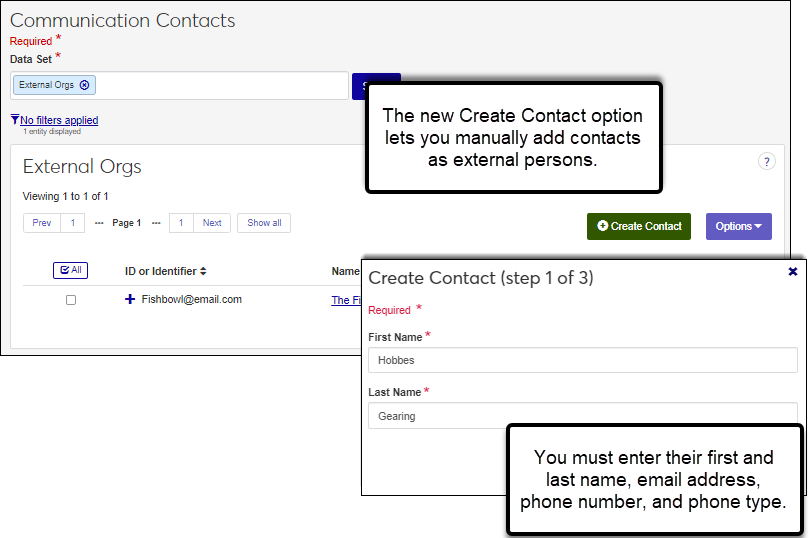
Note
To use this feature, users must belong to a Communication Base role with the Can create contacts permission enabled.
Additional Enhancements
Several pages in Communications now show a video pop-up when you first access the page. Videos provide overviews, tips, and links to additional resources.
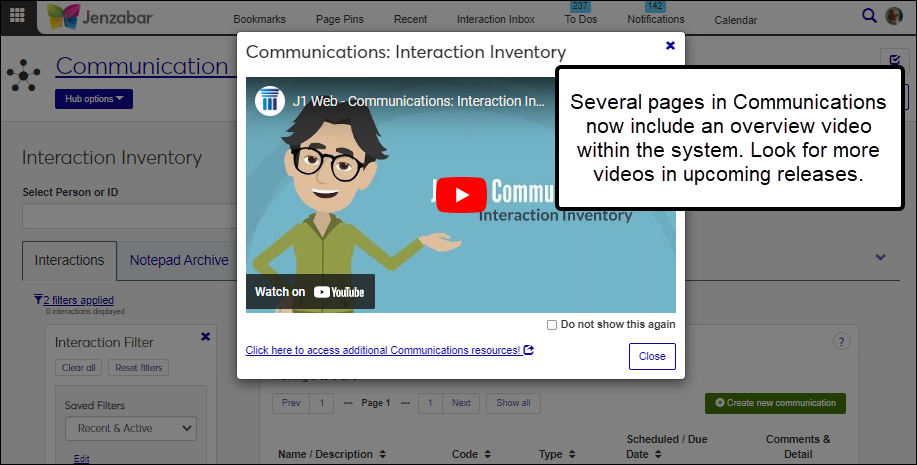
When you view an interaction's run history, you can now see the data set associated with the interaction.
Interactions page now shows Interaction Use as a column and the interaction code under the interaction name.
A notification now appears in J1 Web when you receive a phone call. Opening the notification allows you to access the individual's Person Information Details page, which can provide helpful information about the individual.*
Communication Management permissions in the Core, System Administration hub are now more organized.
Interaction Inbox now shows a SendGrid or Twilio message when an email or text couldn't be sent. You can open the message to see warning information that may help with troubleshooting efforts.*
Interaction Inbox has an updated look.*
Interactions now appear on the same page as opposed to opening in a new window.
Row headings and page navigation buttons were replaced with a Load more button and Sort By link.
*Available with Communications Plus.
Communications Learning Opportunities
Communications offers several learning opportunities:
A full learning plan led by Communications Project Manager, Michelle Way and Senior Software Developer, Sam Stack is available from learn.jenzabar.com and free to anyone interested in learning about Communications. The learning plan is broken out into short, self-paced video courses covering everything from setting up the product to creating automated communication plans and the different types of interactions you want to send out in them. Videos include detailed steps, tips, and recommended best practices, and come with companion PDF guides.
Monthly Communications office hours. This live engagement opportunity allows you to ask your questions, learn about recent enhancements, and hear how others are leveraging the product. Invites are available from the Communications ListServ.
Jenzabar Academy Communications YouTube playlist includes several short instructional videos covering a wide range of Communications features.
Issue | Description |
|---|---|
RN40008 | When email interactions were copied and the email format was changed from "Template" to "Plain text", multiple errors occurred when attempting to save. |
RN40169 | Creating a communication from the Interaction Inventory or the Interaction Inbox produced errors in the browser console. |
RN40316 | When attempting to convert an External person from the Interaction Inbox via the Detail pop-up, the page froze and the person wasn't converted. |
RN40363 | Document interactions weren't applied successfully for certain document storage configurations. |
RN40364 | When an interaction was accessed from the Interaction Inventory, email attachments from an external inbox (e.g., Outlook) didn't save properly for certain document storage configurations. |
RN43023 | On the Data Sets page, clicking Create Data Sets resulted in an error. |
RN43027 | When a communication was sent and resent to a contact via the recipients data set, both instances of the communications contained the same content, even though the data was changed in the system between runs. |
RN43038 | The Interaction Inbox and Interaction Inventory were not loading in a timely fashion. |
RN43776 | On the Interaction Inventory page, the View Details pop-up did not show links for attachments. |
RN43793 | ManagedTaskFutureResult rows were getting stuck in processing and never deleted, resulting in other communications being delayed from going out. |
RN43885 | Interactions that received replies in 2021.3 were missing in the Interaction Inbox after upgrading to 2022.1. |
RN43961 | For Communications Plus users, some texts appeared twice in the conversation feed. |
RN44173 | The merge field was not displaying correctly on student's phones when the merge query failed or timed out. |
RN44174 | Duplicate messages were being sent to students in the Communication drawer. |
RN44175 | The text preview was incorrectly displaying HTML mark up of the text template. |
RN44176 | Outbound messages had the incorrect sender displayed and locked in the conversation drawer. |
RN44393 | Twilio produced error logs related to text messages that had been sent and received successfully. |
RN44455 | Using Twilio to send a new text to a large number of contacts on the system caused the text batch to stall and fail after 30 minutes. |
RN44865 | Additional security was added to the Notification Detail Drawer to prevent users from changing the number on the end of the URL to access notifications that did not belong to them. |
RN45057 | In certain situations, print To Dos were assigned again after the To Do had been completed. |
RN45114 | When users with large amounts of data in the Phone Master selected one number and Edit Forwards, the software displayed an empty dialogue box. |
RN45845 | When a scheduled communication was associated with a merge Data Set that did not include a row for a recipient in the Recipients Data Set, an error occurred and no communications were sent. |
RN46167 | When the Merge data set and Recipient data sets were out of sync, communications were not being sent. |
RN46170 | Unsubscribe responses to text messages did not update CMPhoneForAnyParty status to unsubscribed. |
RN46171 | When setting up an email interaction, if the auto-response content contained a hard return users were unable to continue creating the interaction or save it and finish later. |
RN46593 | In Interaction Sets, even though interactions were sent as scheduled, all completed interactions in the set incorrectly displayed the date and time the second interaction was sent. |
RN46594 | When communications were sent to multiple recipients, and more than one communication failed to send, notifications were sent for each failed communication instead of one notification as expected. |
RN46728 | Interactions in a set were sent after the interaction set was set to inactive. |
RN46813 | When a To Do Phone Call Type interaction was executed as part of an interaction set, the completed To Do Type is listed as Other instead of Phone Call. |
Analytics
Emails and texts opened from the Interaction Inventory, Inbox, and Feed now include a "more details" link to real-time analytic information. The link opens an analytics window where users can view all the status updates for that specific message including how many were sent, delivered, and if there were any issues.
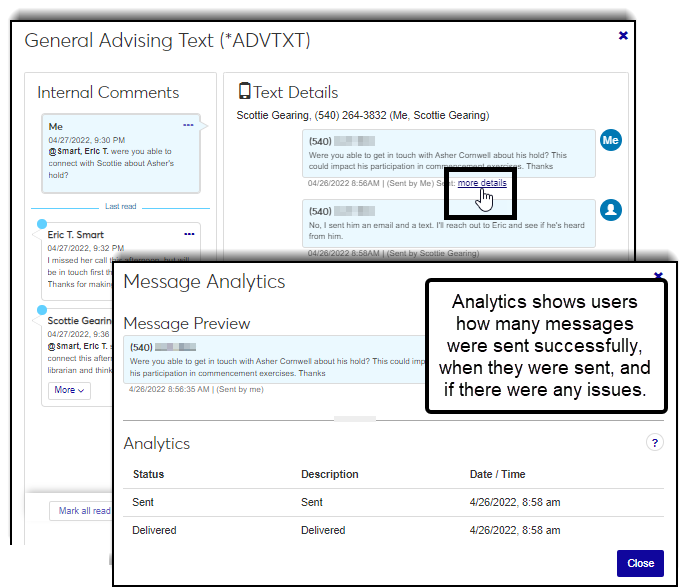
Analytic information is also now available from the interaction run history. Review the recipient list and details like the number of successfully sent messages, how many recipients opened it, if there were any issues, and other helpful information to identify issues and delivery success rates.
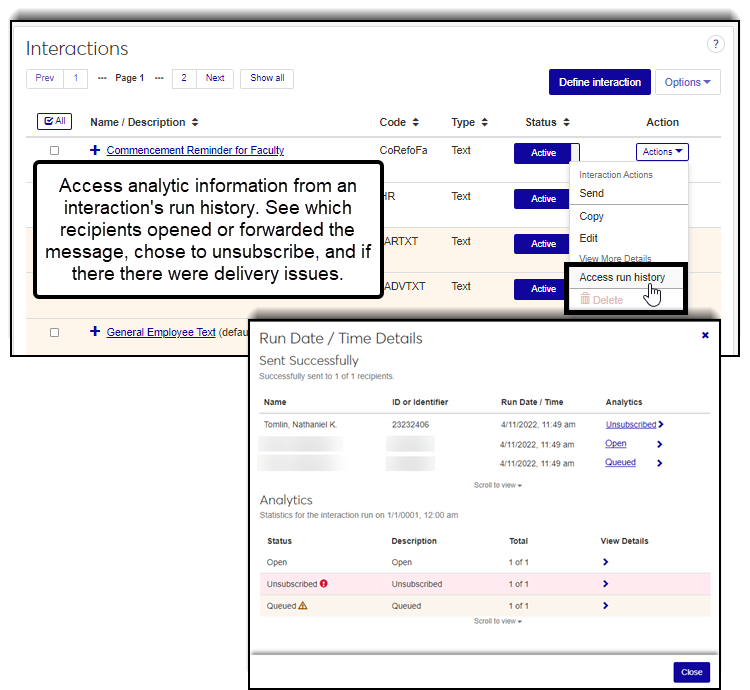
Communication Contacts
New Communication Contacts page lets you:
View recipient lists based on data sets.
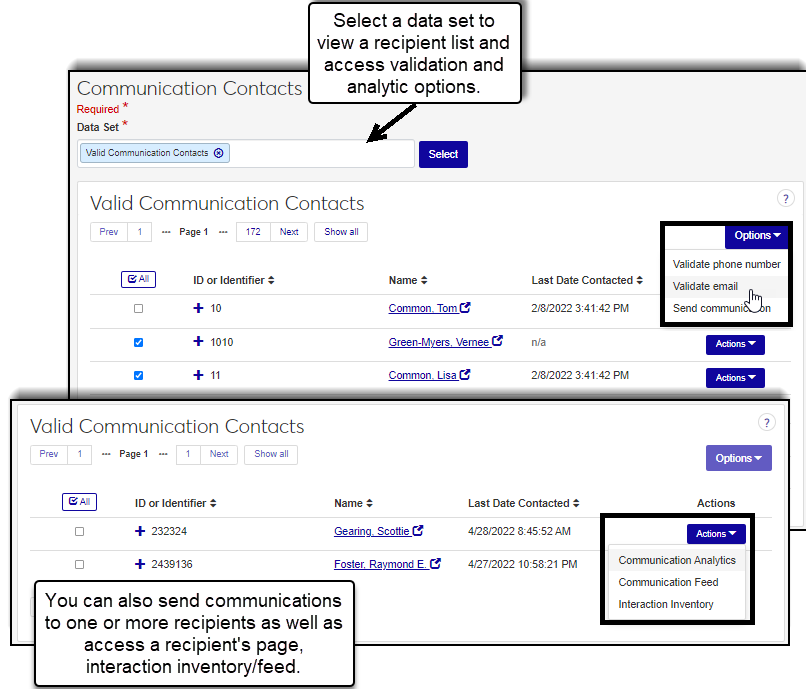
Validate recipient phone numbers/email addresses.*
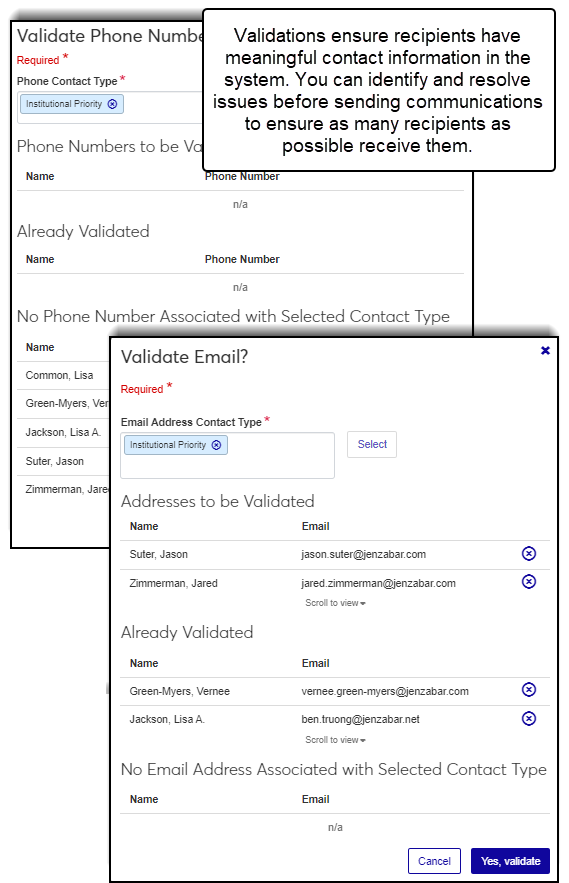
Note
Use the new FormFlow Contact Information Update form to confirm and collect updated contact information from students, faculty, and staff using your campus portal. Updates are immediately saved to the database and do not require internet submission processing and approval. This can help ensure important contact information is accurate. For more information, see the 2022.1 FormFlow Enhancements information and Set Up the Contact Information Update Form help topic.
View recipient communication analytics and access their page/interaction information for more information.
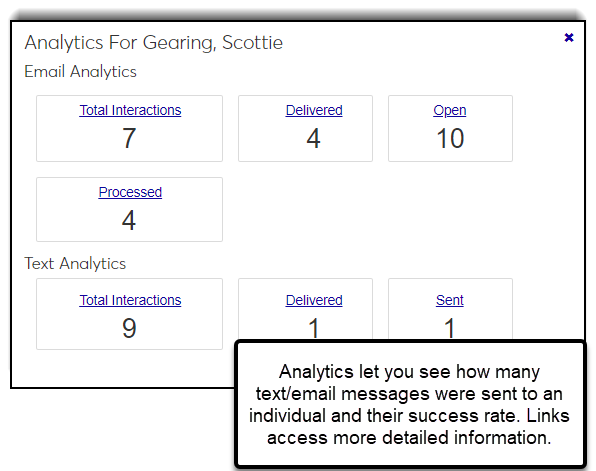
Send communications. For example, if you're working with an incoming freshman data set, you can select students that haven't signed up for orientation a text to remind them of the date.
Access the Communication Contacts page online help for detailed information.
Note
To access this page, users must belong to a Communication Base role with the Can view Communication Contacts permission enabled. To use validation features, users must have Communications Plus and belong to a Communication Management Licensed role with the Can validate contact information permission enabled.
*Only available with Communications Plus.
@mentions
You can now use @mentions to bring an interaction to someone's attention anywhere internal comments are available.
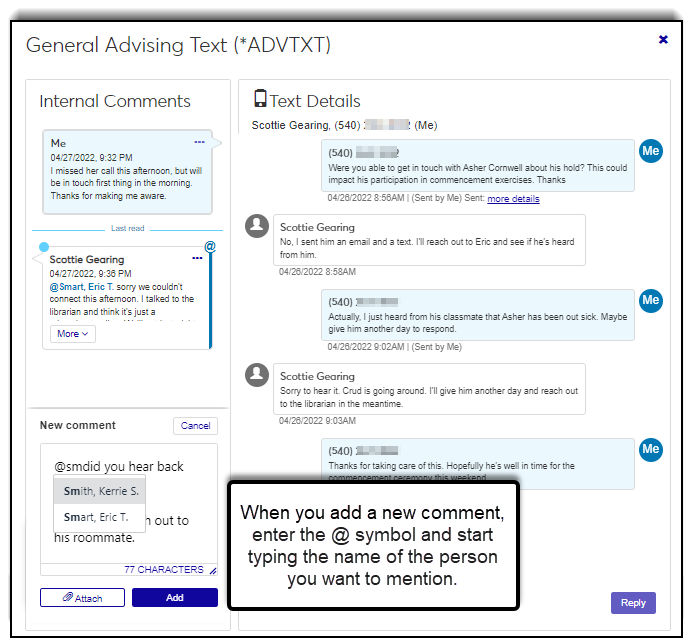 |
Mentioned individuals receive a notification letting them know they’ve been tagged. When they access the notification from the Notification Center, they can link directly to the interaction where they are mentioned.
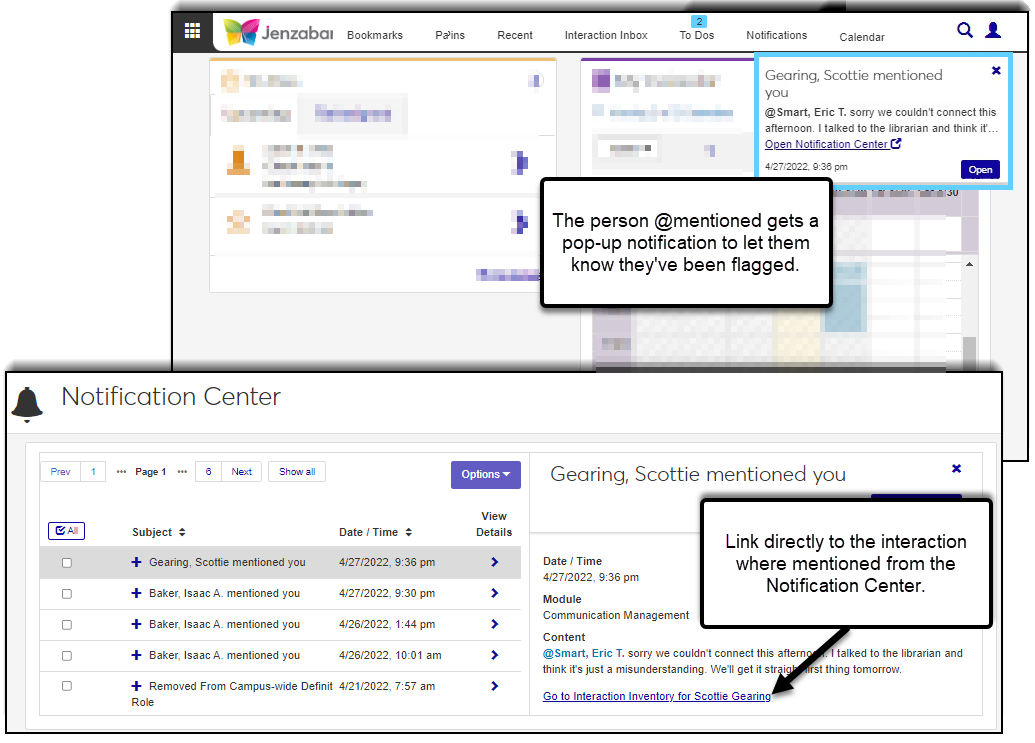
Note
This feature does not require new role permissions. Anyone with access to internal comments can use @mentions.
Create New Communication Updates
The Create New Communication window includes several new options when sending email and text messages.
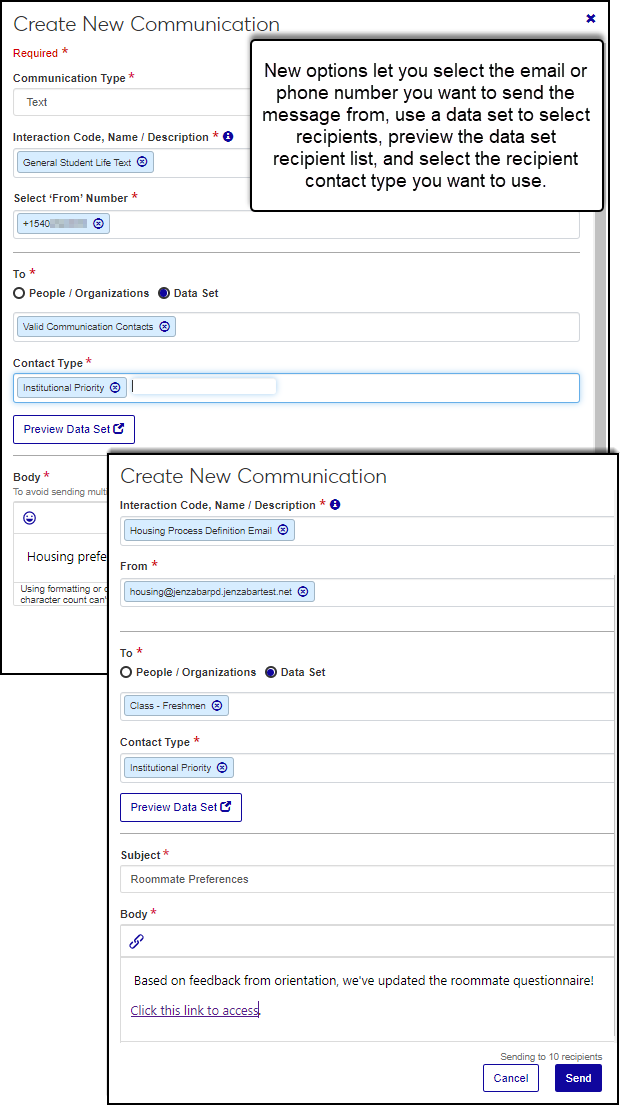 |
New Option to Select Your 'From' Address
If you are assigned to multiple email addresses or phone numbers*, you can now which “From” email address or phone number you want to use when sending a text or email. For example, if you want to send a text from a shared admissions phone number or one shared by the recruitment office.
*Available with Communications Plus.
New 'Data Set' Option for Selecting Communication Recipients
Select from a list of data sets you have access to and send the interaction to anyone with valid/verified contact information in the data set. A Preview Data Set option lets you see the recipient list. Only those recipients that meet the data set criteria receive it.

New Contact Type Option
From the new Contact Type drop-down, you can select which email address or phone number type the communication will be sent to. The system verifies the the recipient/s have a valid/verified contact information for the selected type.
New and Updated Features for All Users
Attachment Pop-Up List
A new pop-up appears when you hover over an attachment icon with multiple attachments. The pop-up lists the attachment file names and types, and indicators let you know which files have already been saved.

New Interaction Use Option
A new "Communication drawer" interaction use is available when defining an interaction. This makes the interaction code available when using the Create New Communication drawer/window. Previously internal recording purposes only were the only interaction codes available.
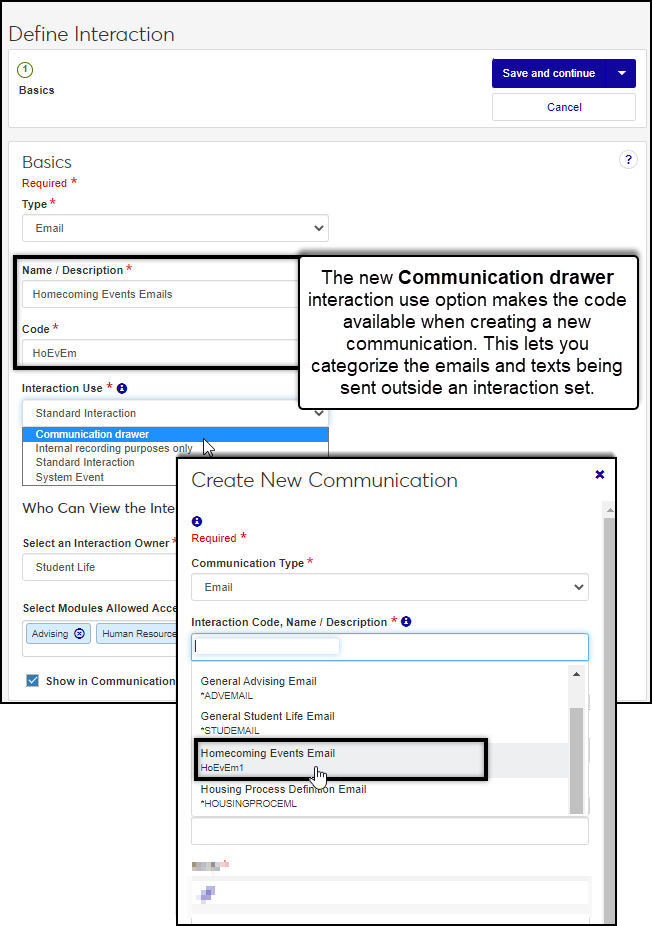
New notifications let you know when interaction and interaction sets have issues.
Create Communication option is now available on the Advisee Spotlight page.
New and Updated Administrative Features
Access Codes
You can now create custom Access Codes from the new Access Codes page in the new Campus-Wide Definitions hub. A code is associated with interactions when they are defined/created. Users in a role with permission to the code will then be able to view/work with those interactions.
Call Forwarding
New settings let you forward calls coming in to your Twilio numbers to a voice-capable line or prerecorded message. This connects callers to an individual or message with more information.
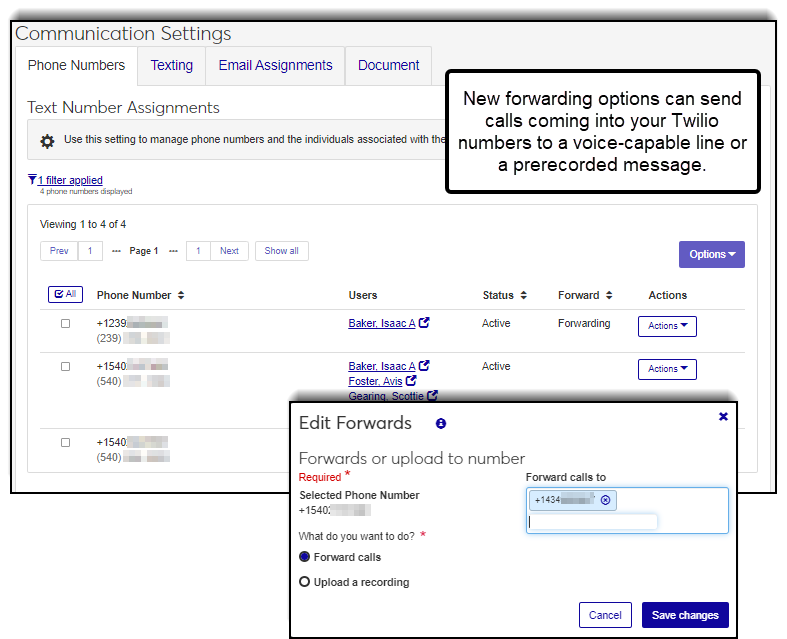 |
Communication Settings Page Updated
The Communication Management hub, Communications page now uses tabs for managing phone number, texting, email, and document settings.
New Phone Numbers tab:
Access options for managing users assigned to Twilio phone numbers.
New forwarding options to send calls coming in to Twilio numbers to a voice-capable line or prerecorded message are described in the Call Forwarding section.
New Texting tab:
Access the Texting Grace Period options (previously available from the Texting drop-down)
Configure your texting template (previously managed on the System Administration hub, Communications page)
The new Email Assignments tab lets you manage users assigned to email addresses and grant designated users temporary access to an email account. When multiple users are assigned to an email address, they can access the shared inbox and work together to respond to incoming messages. Temporary access can be useful for seasonal or student staff, adjuncts, etc. When users with temporary access reach their end date, the system automatically revokes their access to messages associated with that email address/phone number.
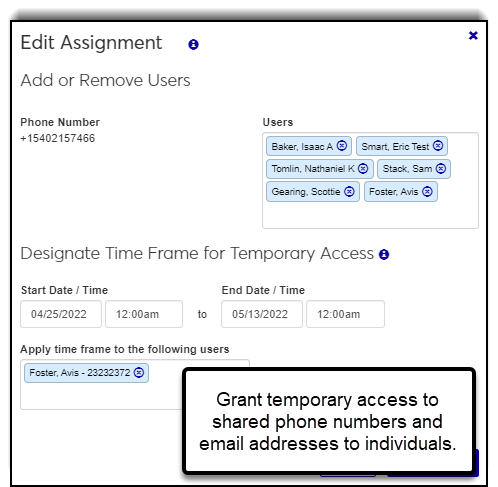
New Document tab lets you manage the document mail merge setting (previously available from the Document drop-down option).
Note
To use these features, users must belong to a Communication Management base role with the Can manage settings permission enabled.
Define Interaction Sets Updated
The Recipients step of the define interaction set process includes several updates and new options.
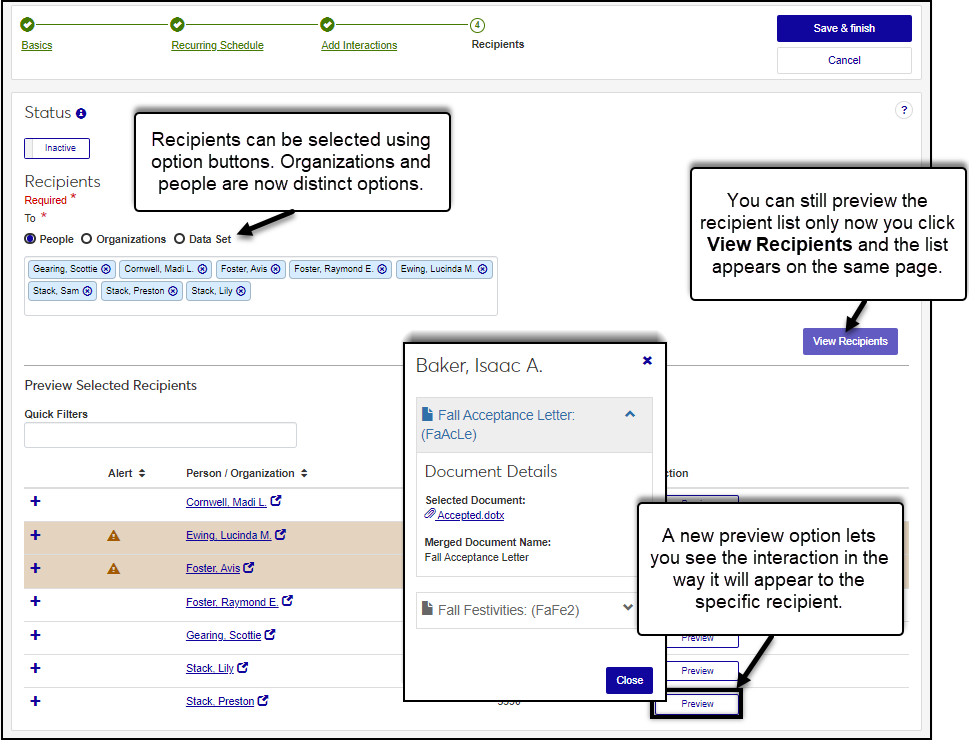 |
Recipients were previously selected from a drop-down menu and options were limited to people/organizations and data sets. Options are now broken out so you can select people or organizations or data sets.
The View recipients option now shows the recipient list on the same page and provides a filter option to make finding a specific recipient easy.
A new Preview button next each recipient's name lets you see the interaction how it will appear to the specific recipient.
SMTP Options Now Available in J1 Web
SMTP Relay Configuration options for Client Application Services are now available in J1 Web, System Administration.
Issue | Description |
|---|---|
RN31569 | The Interaction Inbox unread message count didn't update when messages were read (Universal toolbar). |
RN32327 | A loading error occurred when users attempted to delete an incomplete or inactive interaction. |
RN33053 | The scheduled job to process temporary attachments failed because the directory path used to hold temporary attachments was not valid. |
RN33942 | For Communications Plus users with Message Forwarding enabled, messages were not forwarded to the interaction inbox. |
RN35610 | Large SQL files didn't upload correctly as data sets (Data Sets page). |
RN36069 | Communications were received by the wrong group when the interaction set rules were applied. |
RN37086 | Emails sent from the interaction didn't consistently incorporate merged data fields for large recipient groups. |
RN37607 | The Sent view produced a loading error in the Interaction Inbox. |
RN37814 | Attempting to upload an SQL Query for a recipient Data Set produced an error when the "DISTINCT" keyword was used but no "ORDER BY" clause was provided. |
RN37846 | Document Interactions failed to run when they were applied to recipients that weren't in the merge data query. |
RN38202 | The Notepad Archive tab on the Interaction Inventory page failed to load when a person or ID wasn't selected. |
RN39589 | Interaction details didn't display in the Interaction Inventory for certain document storage configurations. |
RN40033 | Interactions that used the Name Details data set timed out and didn't send when there were a large number of NameMaster rows. |
2021.3
2021.2 Introduces the Full, Licensed Version of Communications!
| The licensed version of Communication Management is available with 2021.2. Communications Plus offers:
|
Sending a Text
You can send texts to any constituent in the system with a valid, verified, SMS-capable phone number.
Note
Recipient phone numbers are managed on the Desktop, Name Entity window.
Users assigned to a phone number in J1 Web can use the new Text Communication Type option to send text messages from the Create New Communication window. Text messages are sent in plain text, but you can insert emojis and type out web addresses.
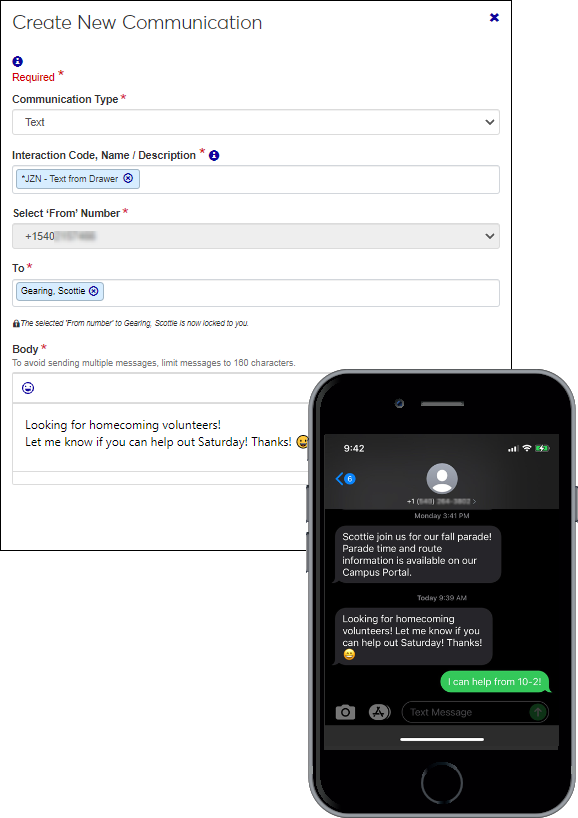 |
Note
Jenzabar provides several general text interaction codes so you can get started with texting right away; however, to collect meaningful data for analysis, Jenzabar recommends defining your own internal use only text interactions (Define Interaction process).
The define interaction process lets you create text messages that can be sent immediately, scheduled, or saved and combined with interaction sets that are sent according to a schedule you create.
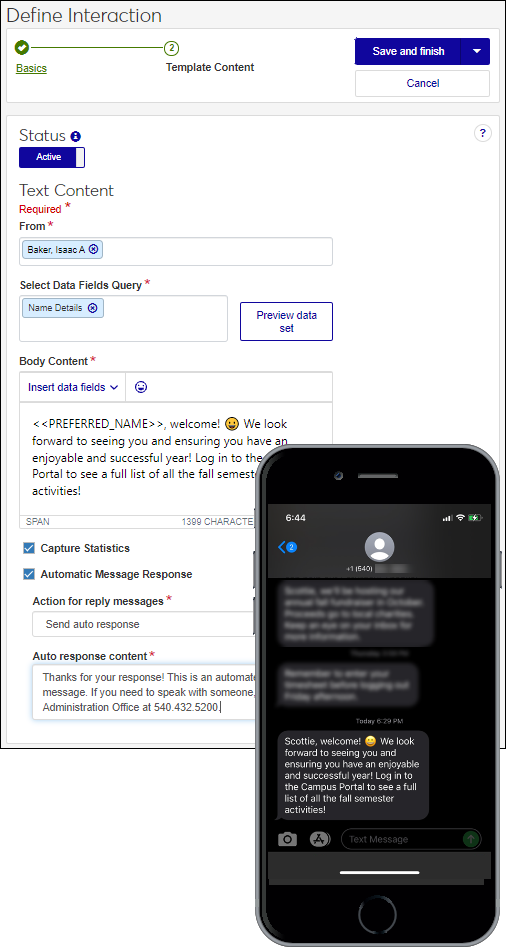
To view and reply to texts, access the Interaction Inventory as well as the new Communication Feed and Interaction Inbox.
Communication Feed
The Communication Feed is accessed from the View feed icon on individual and organization pages and lets you view the scheduled, recent, and past communications associated with the individual/organization.
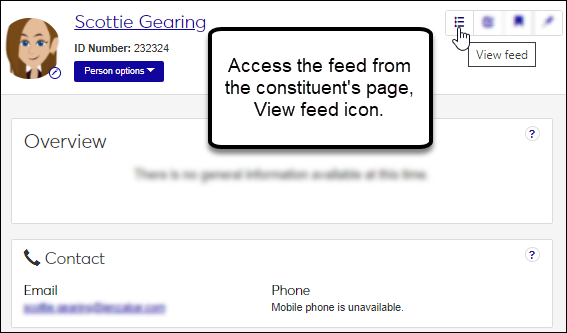
The feed shows interactions in chronological order and includes options to access detailed information and show more interactions.
Note
You can only see communications you have permission to access.
Icons indicate the type of interaction and blue indicators alert you to unread interactions and comments.

Click a view details icon > to access detailed interaction information. From the interaction window that appears, you can see the interaction's content, view and add internal comments, and if you are included on the exchange, use reply options to send a response. Blue indicators alert you to unread comments.

Interaction Inbox
The new Interaction Inbox provides a centralized location for viewing and responding to texts and emails you have sent or received in real-time. Access the Interaction Inbox from the Universal Toolbar.
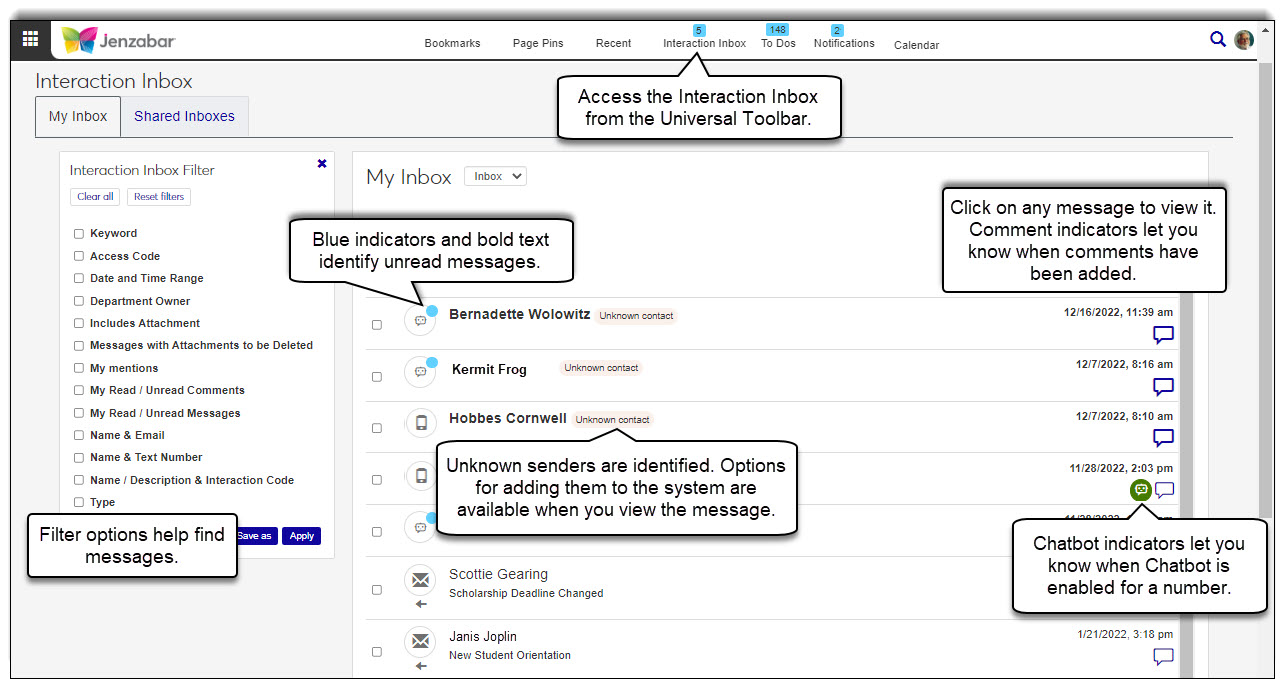
Like the feed, icons indicate the type of interaction and blue indicators alert you to unread interactions and comments. You can sort by headers and use filters to find specific communications.
Click View detail to access the interaction. From the interaction window, you can see the interaction's content, view and add internal comments, and use reply options to send a response.
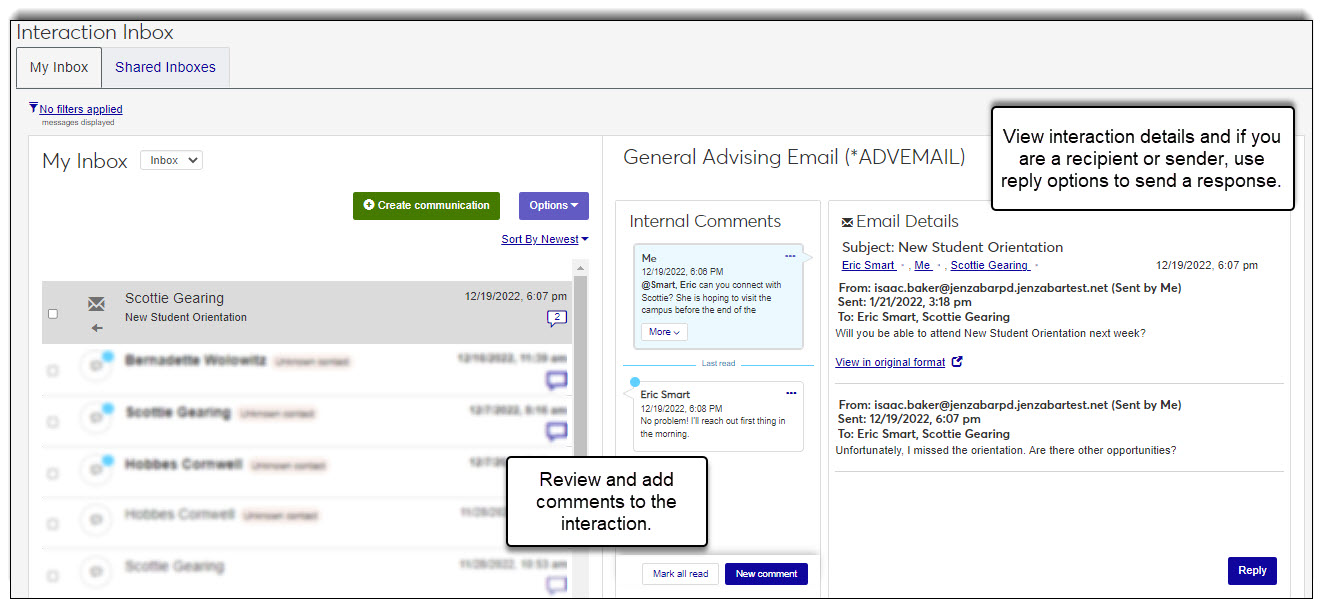
Important
To access the Interaction Inbox, users must be assigned to the new Communication Management Licensed role with the Can access interaction inbox permission enabled.
Enhanced Email Features
The define email interaction process includes a new Template format option.
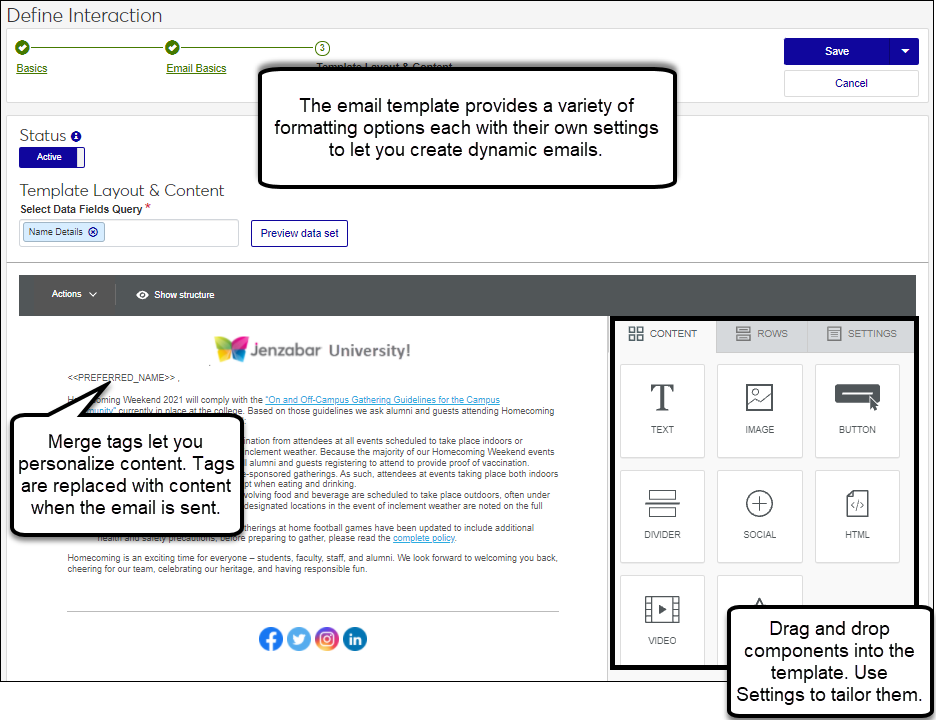
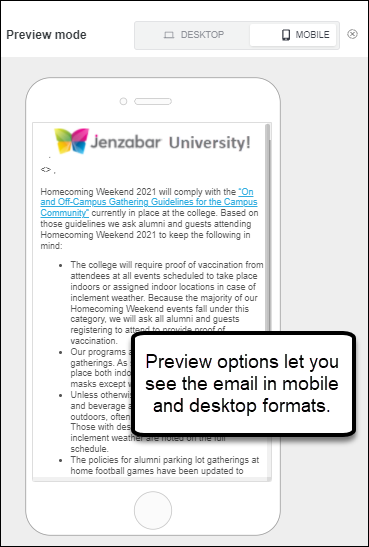
Texting Setup

Apply the Communication Plus license. Contact your Customer Success representative for more information.
Create an account with Twilio and assign J1 Web users to the numbers you purchase.
To ensure immediate, bi-directional interactions work correctly, your school will need to collaborate with your IT department to update your DNS settings.
Set up J1 Web configurations:
Enter your Twilio account security ID and authorization token in J1 Web (System Administration, Communications, Texting Provider).
Configure where incoming file attachments will be temporarily stored and how frequently you want them deleted (System Administration, Communications, Attachment Files).
Compose a welcome message that will be the first text recipients get after they opt to receive text messages from your school. Federal government guidelines require including information about opting out (System Administration, Communications, Texting Template).
Verify your data definitions:
Ensure phone carriers your recipients may be using are available and active. Jenzabar provides commonly used phone carriers, but you can add others.
Ensure the appropriate phone types are active and prioritized in the order you want the system to look for them when sending a text. For example, if you make *CUR the first priority and *LHP the second priority, then when a text is sent, the system will look for a phone number in the *CUR first. If a number isn't found, it will look for one in the *LHP.
Note
Phone numbers are managed in the Desktop (Name Entity window). Recipients must have an active, verified, SMS-capable number in the system in order to receive text messages.
Set up user permissions.
Verify users who will define text interactions are assigned to the Communication Management Base role and have the interaction permissions enabled. Jenzabar recommends granting these users add, edit, delete, view, and apply interaction permissions. Users that will only be sending/responding to text messages do not need this level of permissions (System Administration, System Roles or System Users pages).
Verify users that will be sending/responding to texts are assigned to a role with access to the appropriate interactions enabled (System Administration, Edit Role, Interaction Access tab).
Assign users who will be actively texting constituents to the Communication Management Licensed role so they can access the Interaction Inbox. This step is optional as texts can be viewed and sent from the Interaction Inventory and Communication Feeds, but the Inbox provides a centralized location for working with texts and emails (System Administration, System Roles or System Users pages).
Ensure recipients have valid, SMS-capable phone numbers.
There's no need to evaluate every potential recipient in the system. J1 Web lets you know when a text cannot be sent due to invalid or missing information. In 2021.2, contact information is managed in the Desktop, but a future release will include the ability to update contact information in J1 Web.
Define "internal use only" text interaction types to categorize texts you want to send.
Jenzabar provides several default text interactions that can be used for general texting purposes. Defining additional text interactions lets you create different types of texts that can be tailored and reused in interaction sets.
New Communication Schedules Block
A new Communication Schedules block on the Communication Management Hub page shows interaction schedules queued to run on a selected day. Interaction schedules determine when an interaction set, or series of communications, will go out. This new block lets users click on a schedule to see recurrence information and the sets and interactions associated with it.
For more information:
Interaction Schedules Video: Working with Schedules
Communication Schedules help page: https://jenzabarhelp.jenzabar.com/ews/help/J1Web/released/en/communication-schedules-calendar-block.html

Important
Users in the Communication Management Base role with the Can view schedules permission enabled can access this block.
New Interaction Errors Block
A new Interaction Errors block on the Communication Management Hub page provides a consolidated list of issues that impacted the system's ability to send/apply interactions. Common issues include technical problems and missing/invalid contact information. Errors can still be seen on the interaction's Run History block and page as well. For more information, see the Interaction Errors help page: https://jenzabarhelp.jenzabar.com/ews/help/J1Web/released/en/interaction-errors-block.html
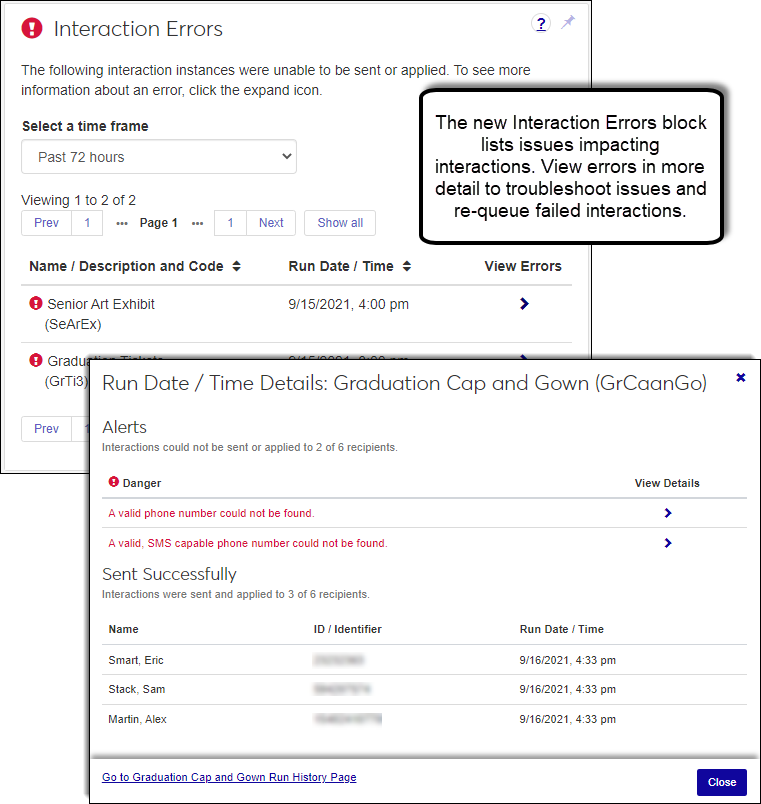
Important
Users in the Communication Management Base role with the Can view interactions permission enabled can access this block.
Send Notifications to Students, Faculty, and Staff in the Campus Portal
Notifications can now be sent to Campus Portal students, faculty, and employees that are not in J1 Web. Notifications will pop-up in their active web browser even when they are not actively using the Campus Portal. There are no new settings or processes to use this new feature. Create/apply the appropriate notification and then send it selected students, faculty, and employees or use a data set query to select the recipients for you.
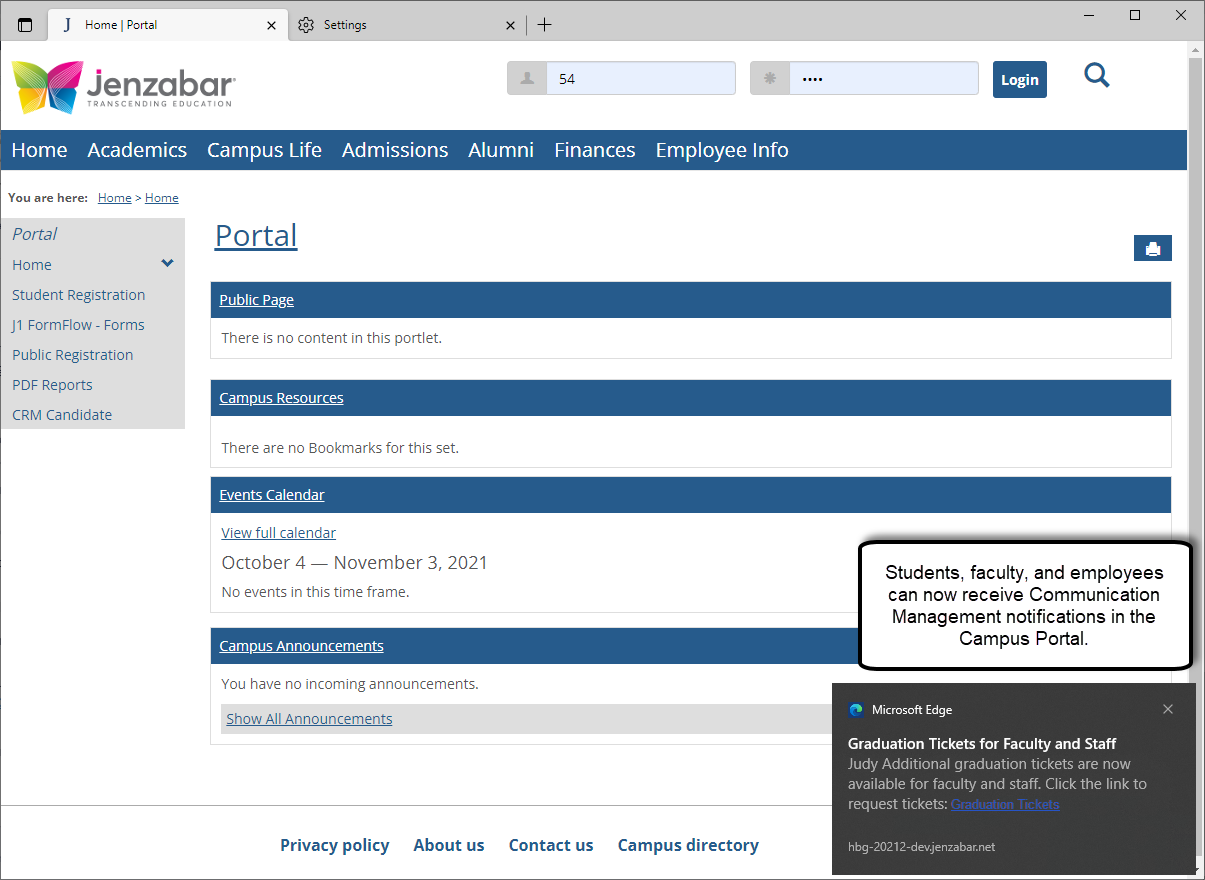
Note
To see the notifications, recipients must allow alerts/pop-ups for your Campus Portal site. Depending on their browser settings, they'll be prompted to accept the pop-up the first time one is sent or they may need to access their browser settings and add the site to their allowed alerts/pop-ups.
Additional Enhancements
InfoMaker PBL queries can now be uploaded and used to create data sets for determining interaction content and recipients.
Data sets are now uploaded on the Data Sets page and selected during the define interaction process.
Failed interactions can now be re-queued to try sending/applying again.
A new option to assign a print document To Do to someone is available as part of the define document interaction process.
Several updates to define interaction processes make creating and activating interaction templates even easier.
A new Queued Interactions tab on the Schedules page shows individual interactions scheduled to go out.
Interaction Set Summary window now provides more detailed information and links to associated interaction pages.
Emails sent from the Create New Communication window can now be sent to multiple recipients.
New Document Storage options let you store J1 Web files and attachments in multiple locations including a network location. For more information, see the 2021.2 Desktop Common Enhancements section.
Issue | Description |
|---|---|
RN25485 | On the Interaction Inventory page, in the Select Person or ID field, the search didn't return people whose ID had 3 digits. |
RN27312 | On the My General Settings page, Communication Preferences, Communication Forward section, the Forwarding Email Address drop-down showed email addresses from domains not allowed by the To Do and Interaction Forwarding setting in Communications settings. |
RN27313 | The To Do and Interaction Forwarding Domain setting in Communications setting was inadvertently case sensitive. |
